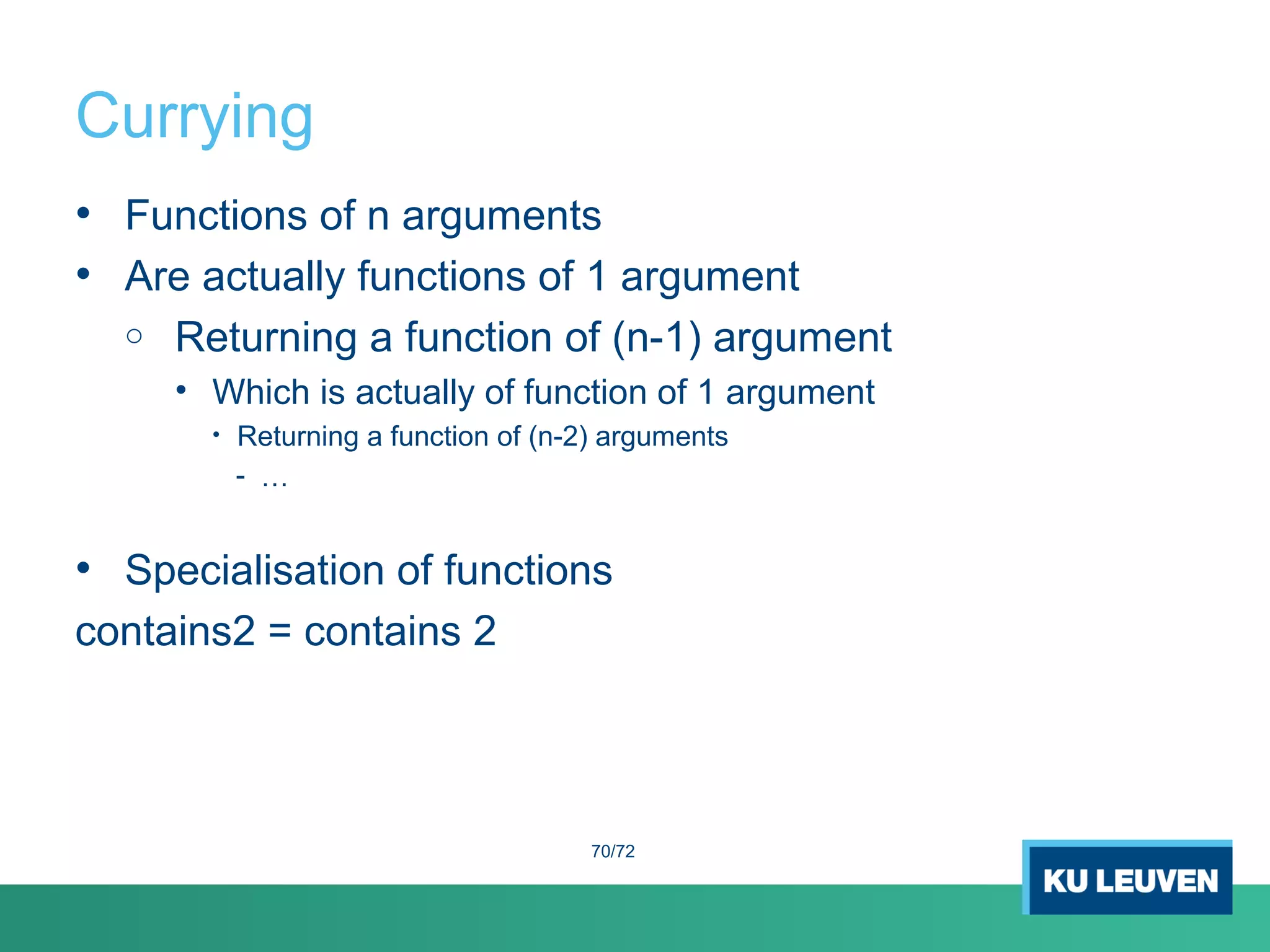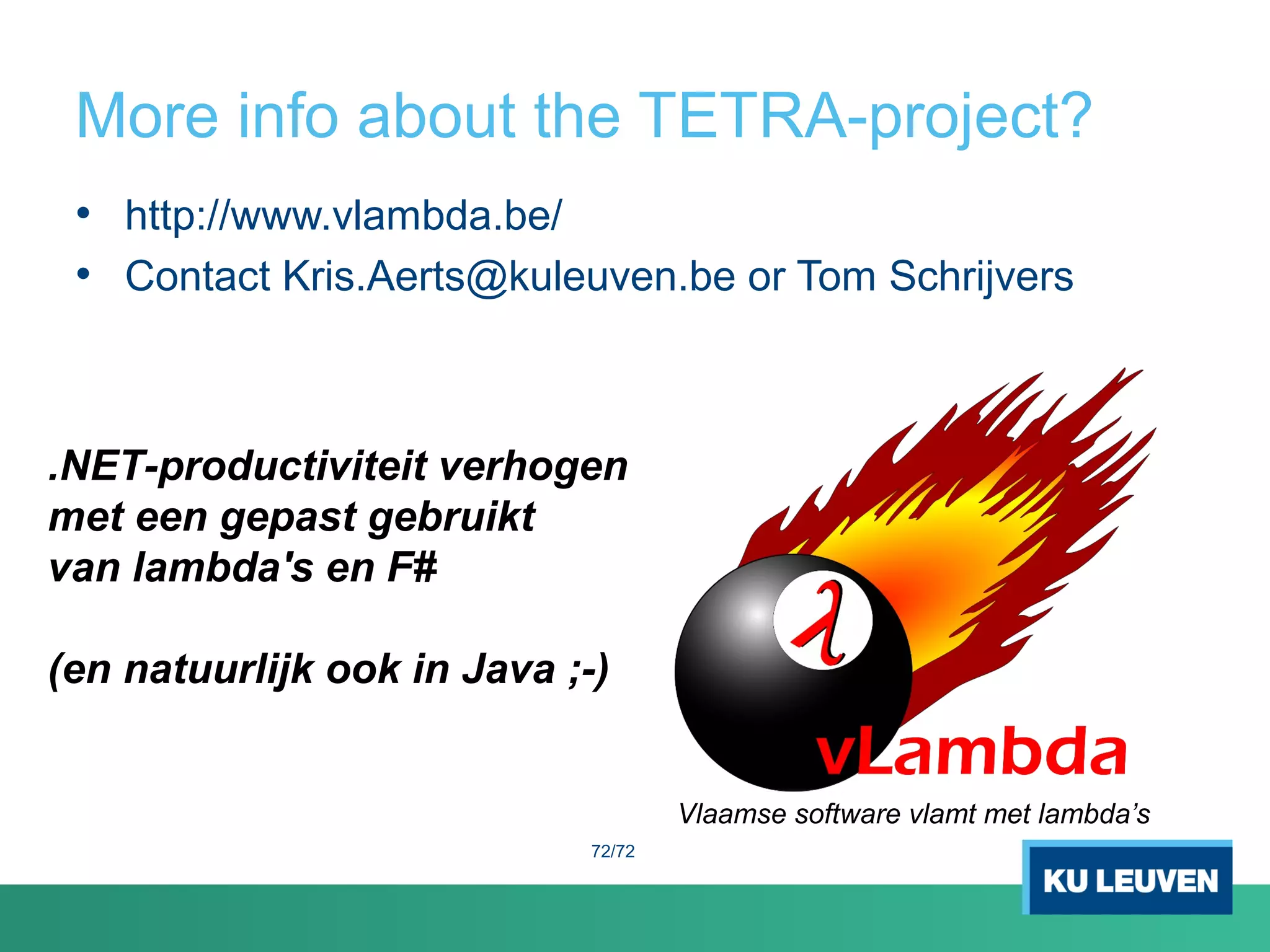This document discusses functional programming and provides examples in Haskell, F# and C#. It begins with an introduction to the author and their background in functional programming languages like Prolog, Haskell and F#. It then covers various functional programming concepts like recursion, pattern matching, avoiding side effects, strong typing and type inference. Examples are provided for sorting lists, calculating factorials and other common functional programming tasks. The document emphasizes the declarative nature of functional programming and compares approaches in Haskell, F# and C#.


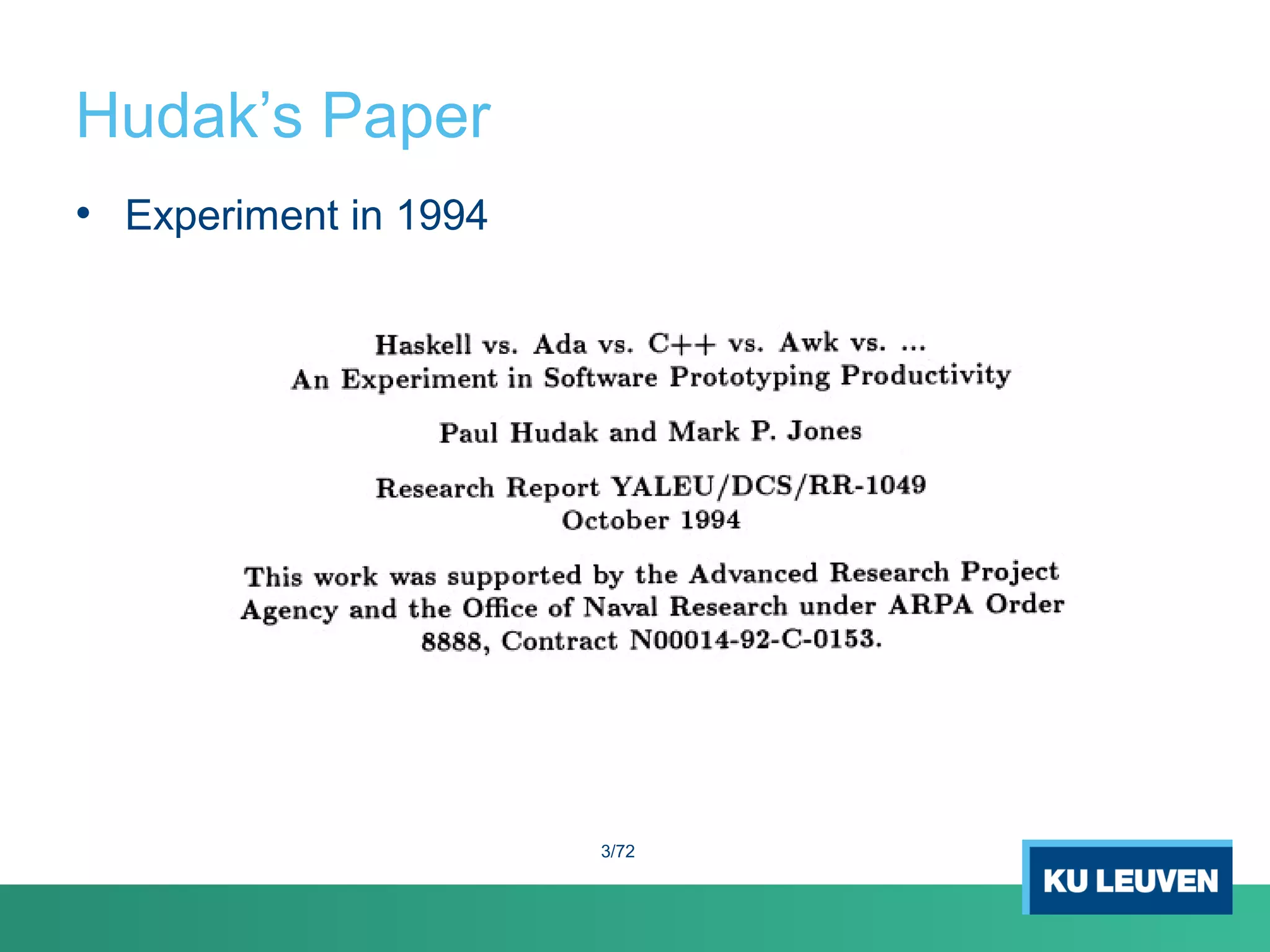

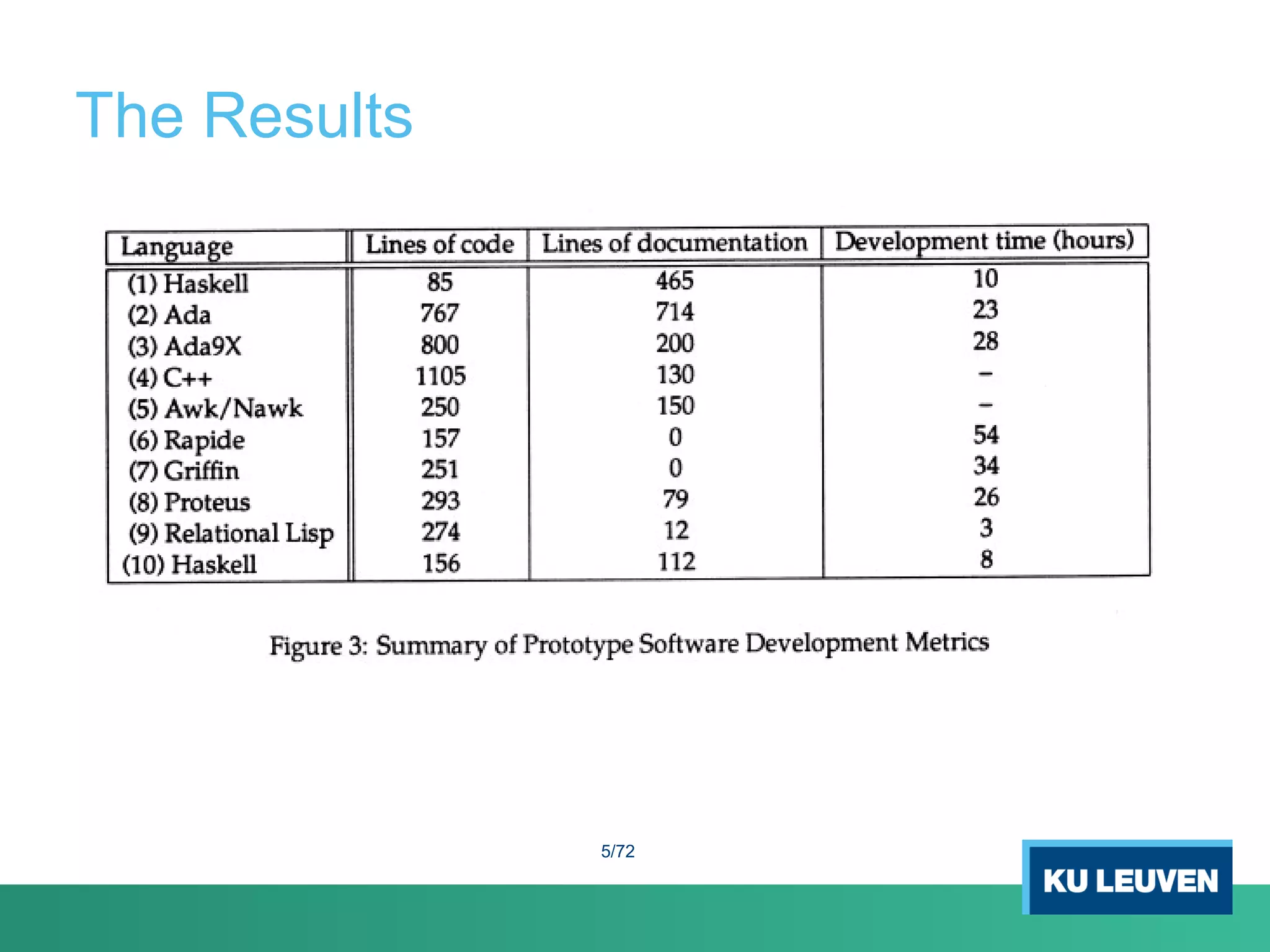
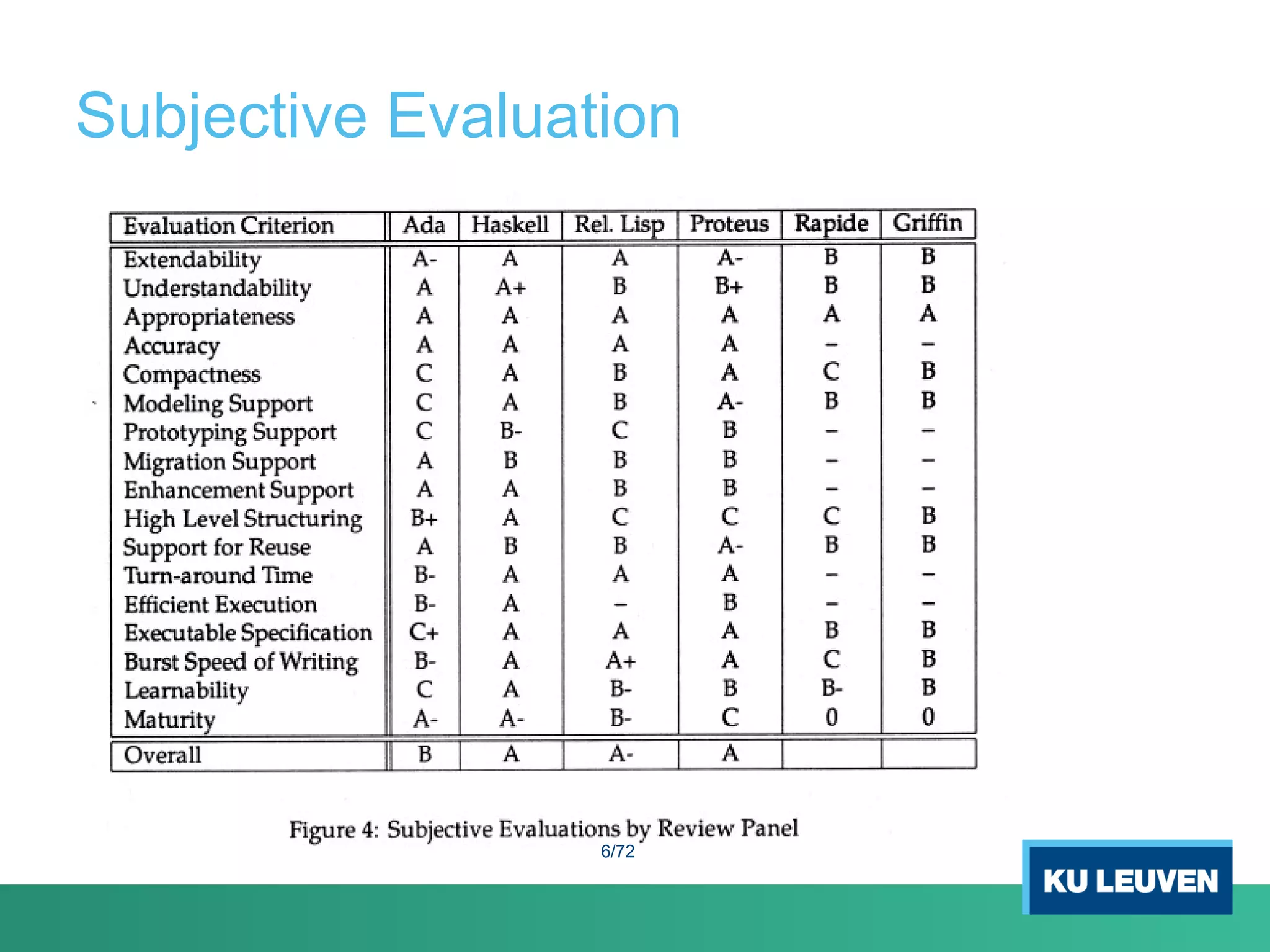
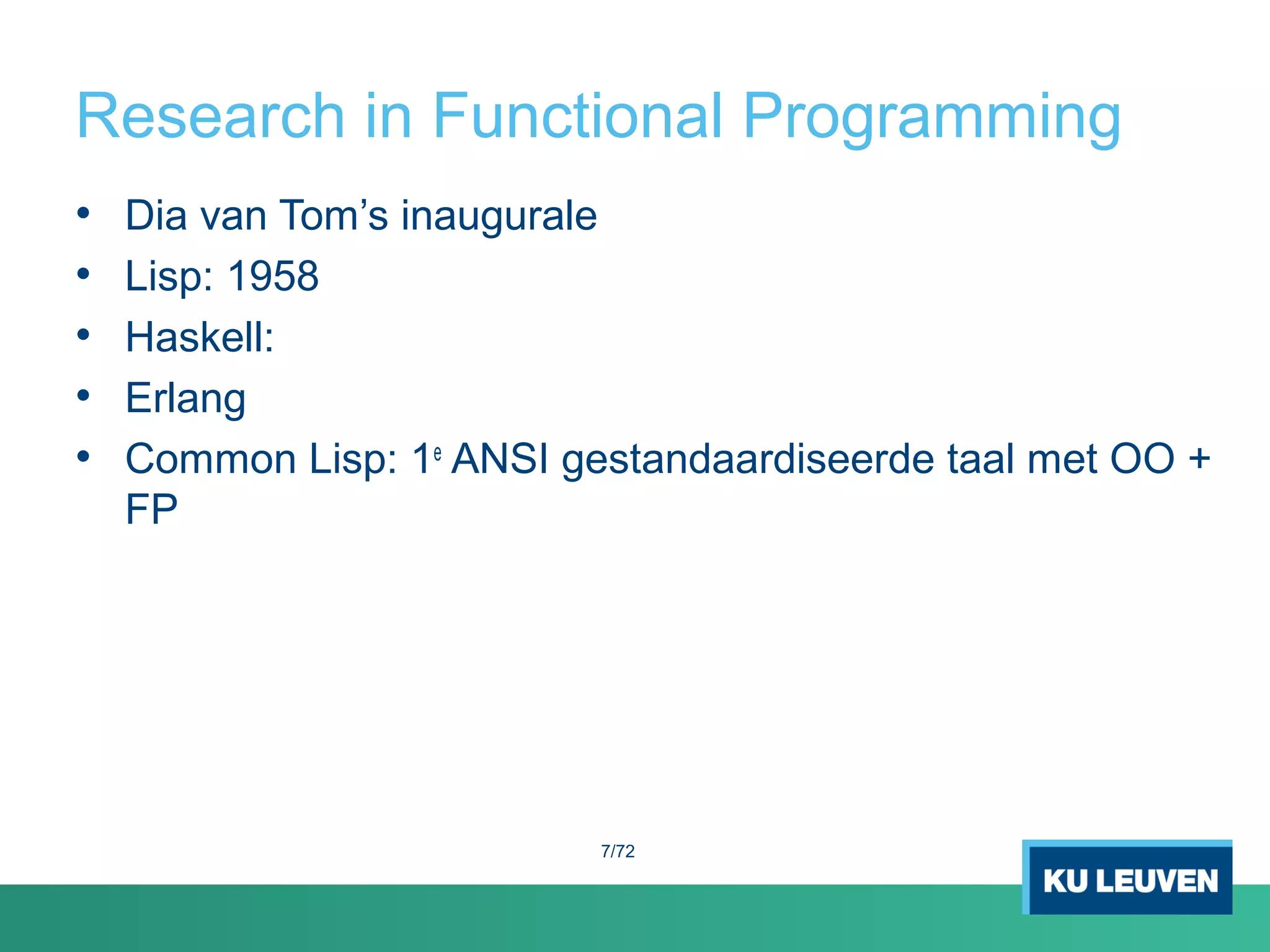
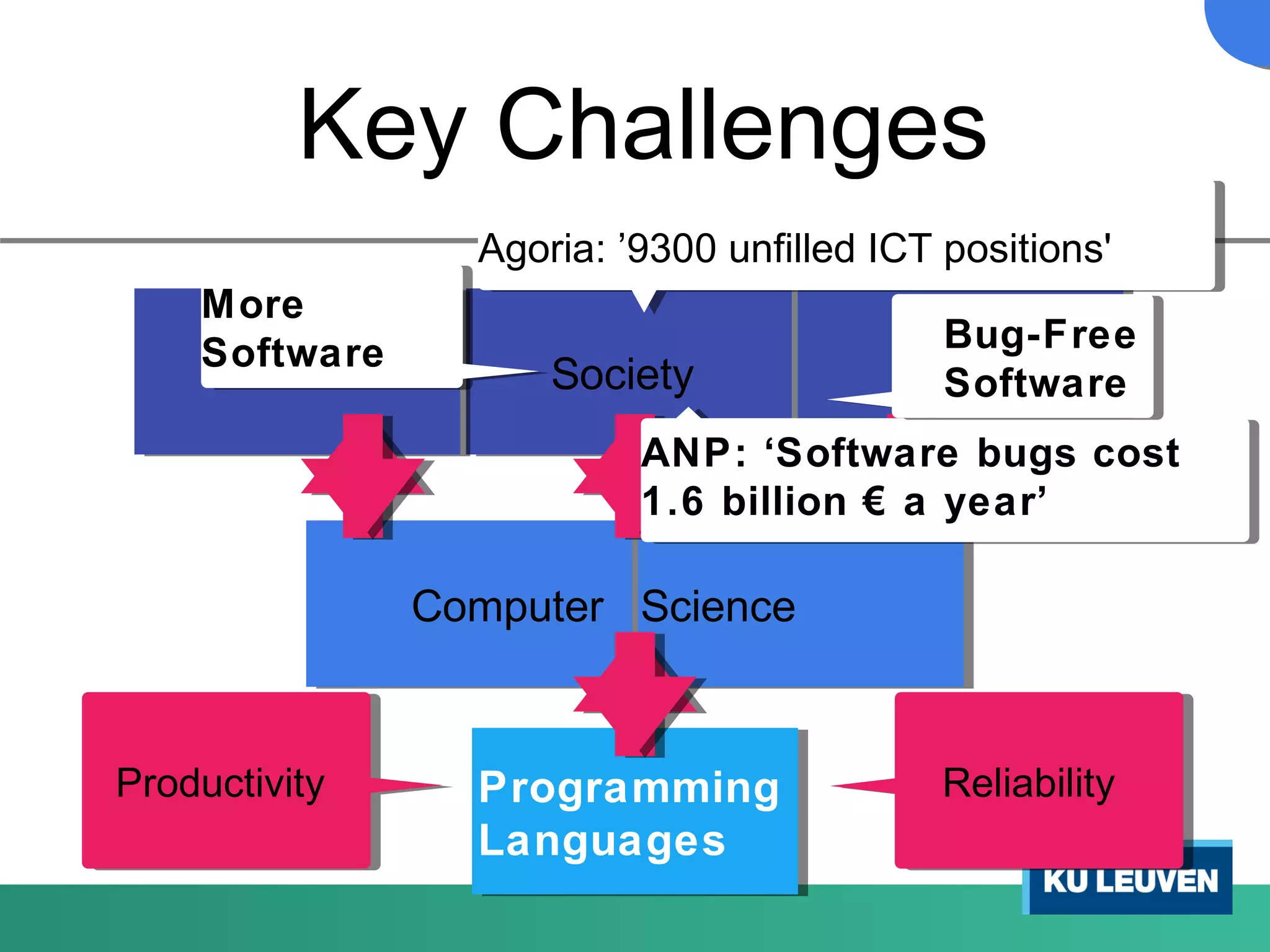
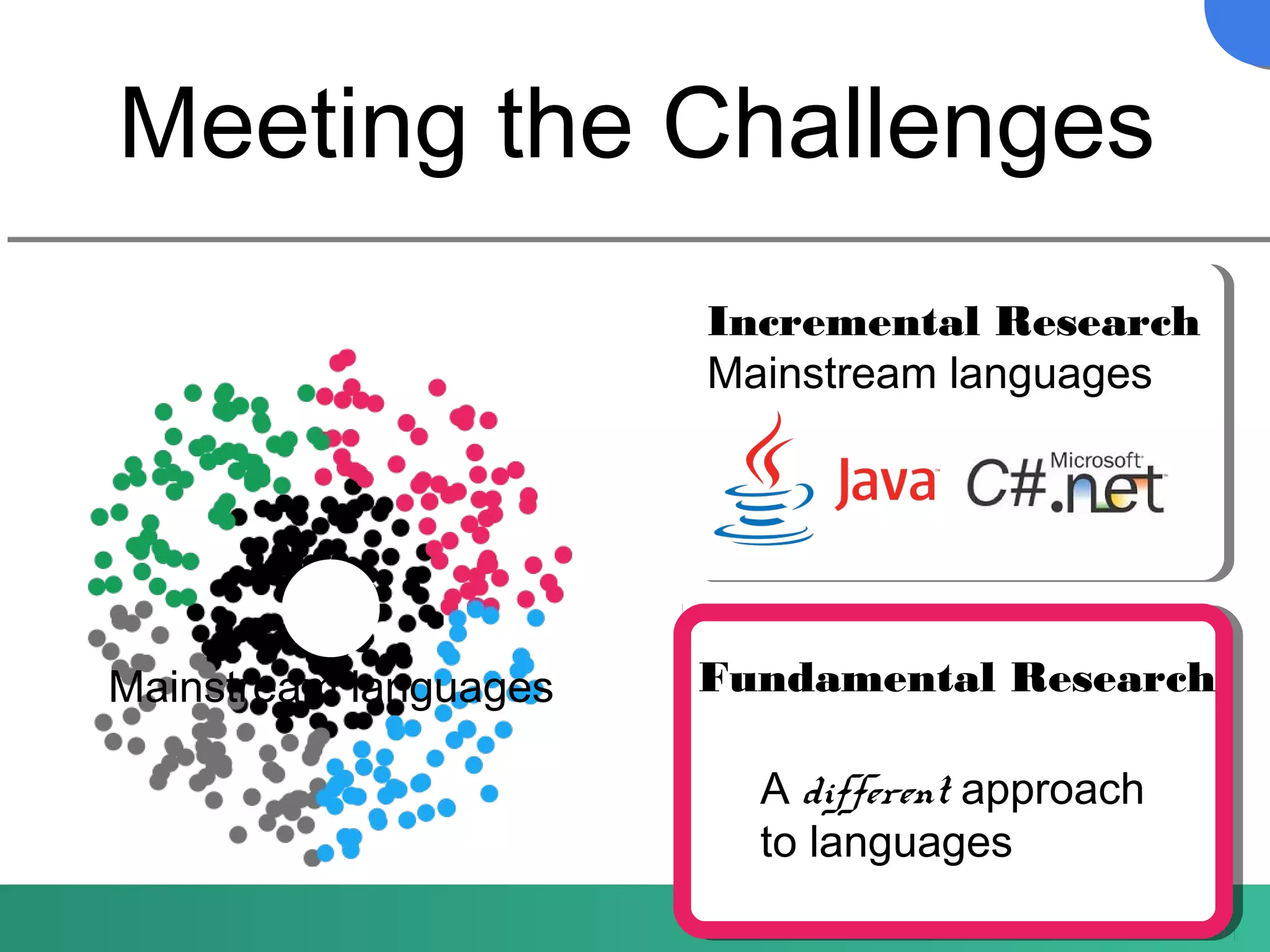


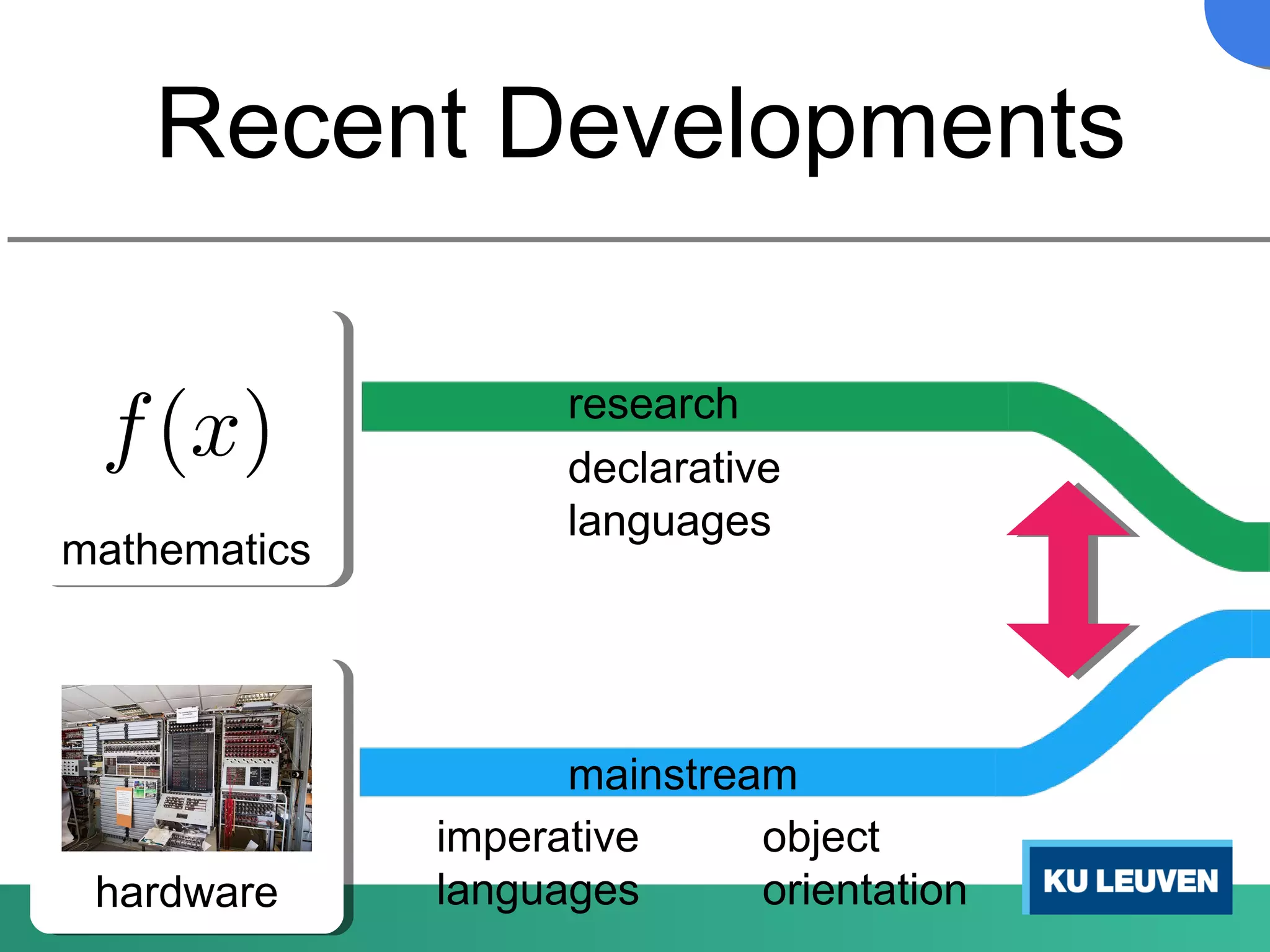

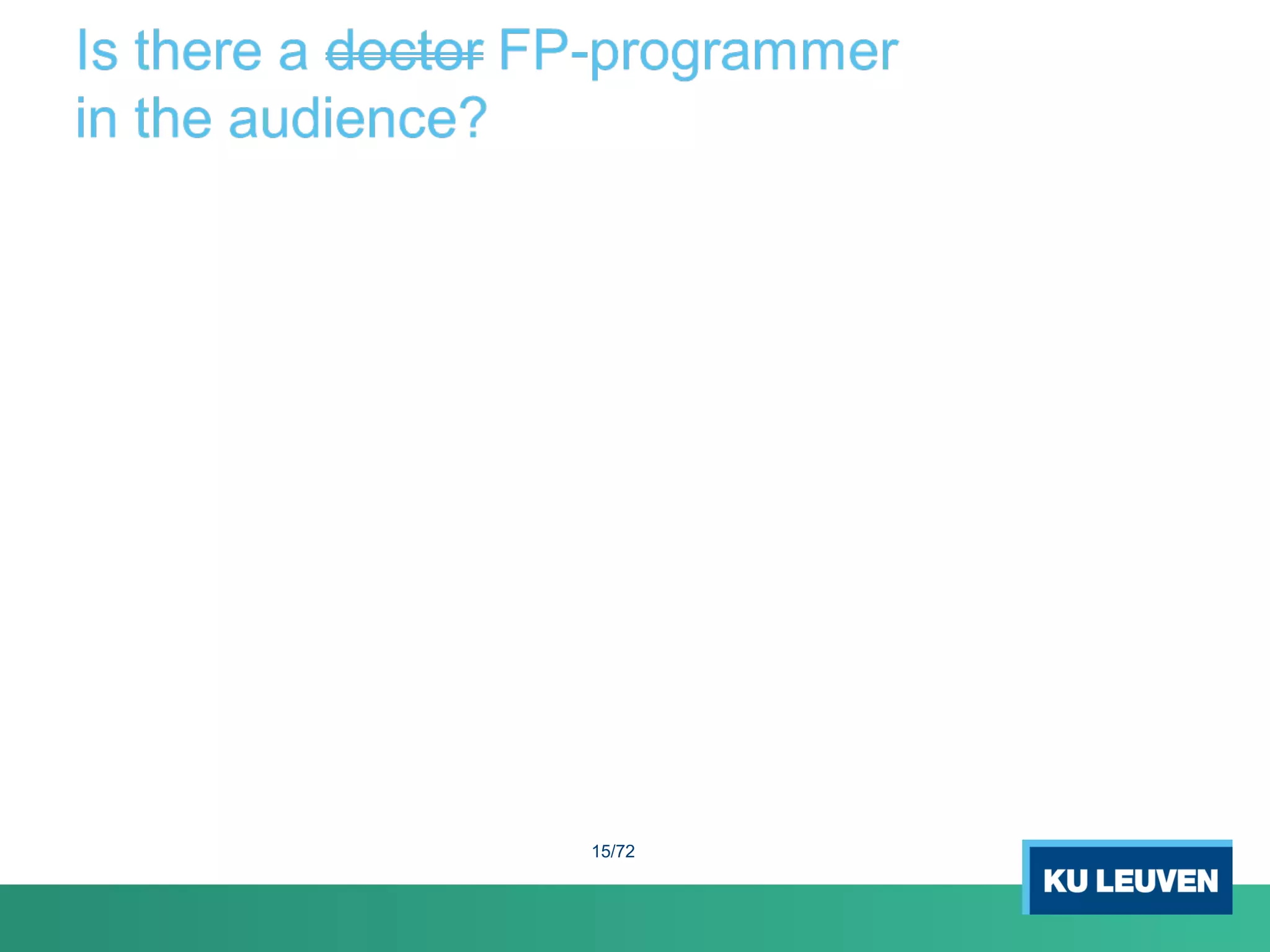
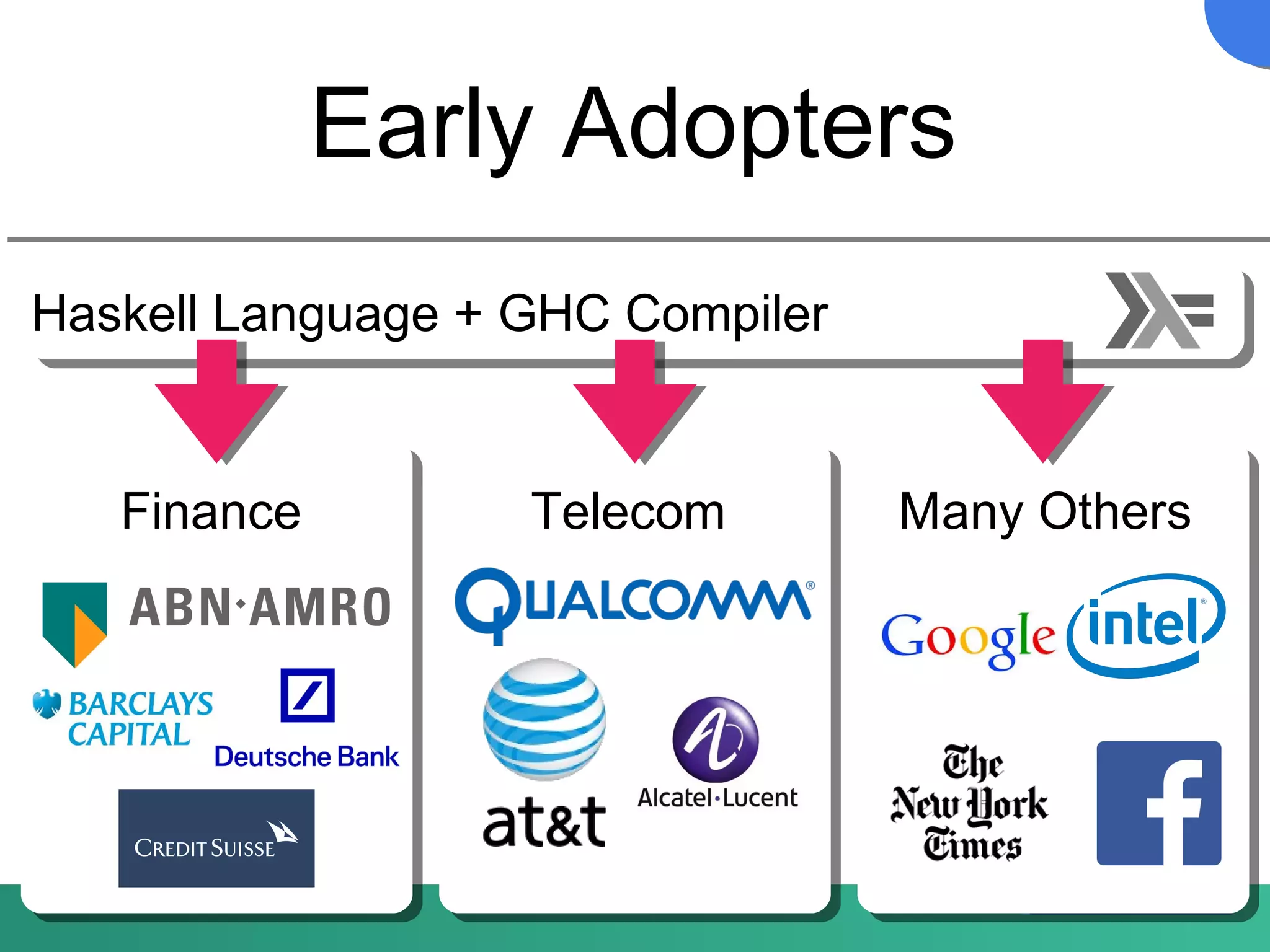


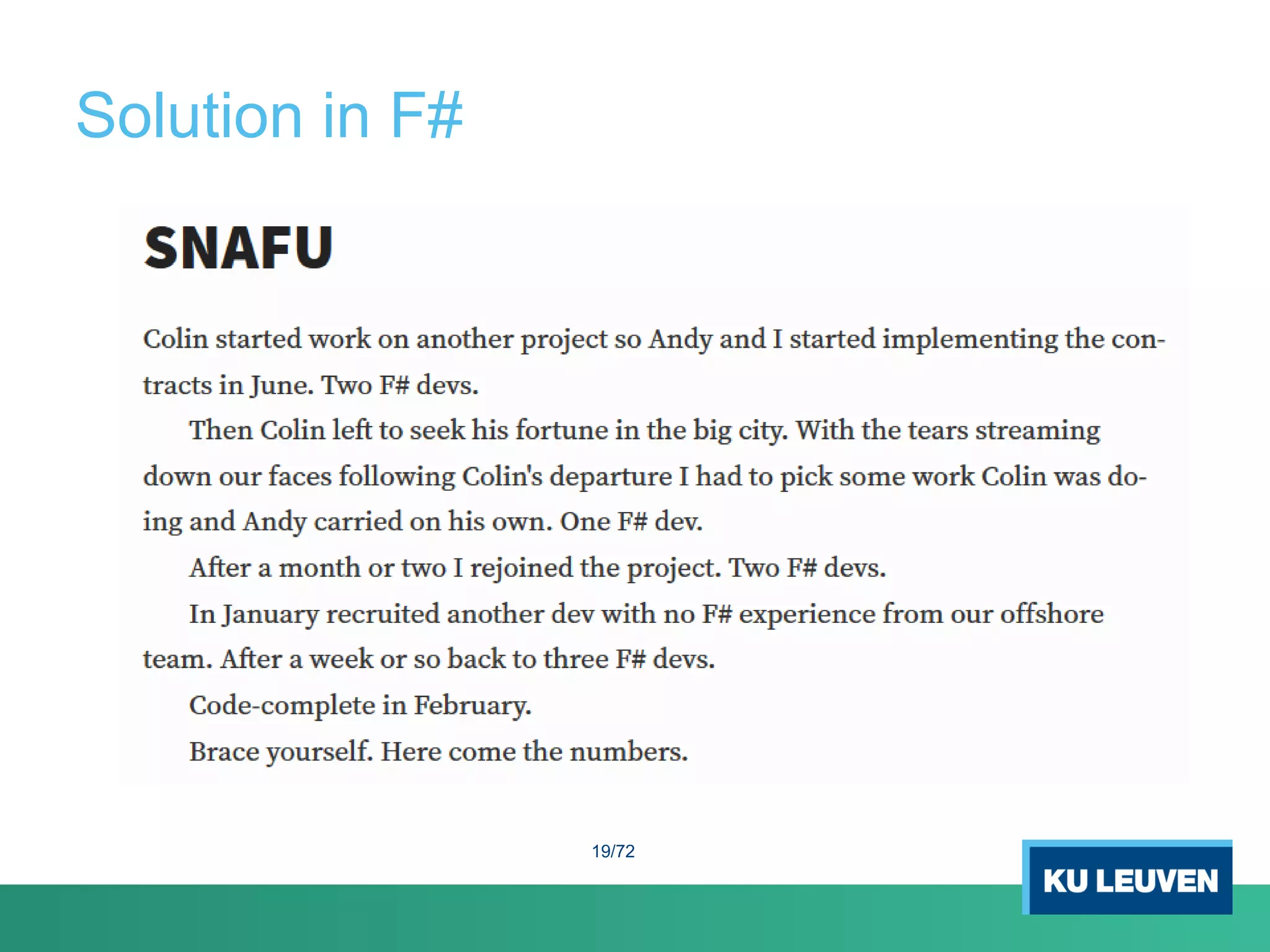
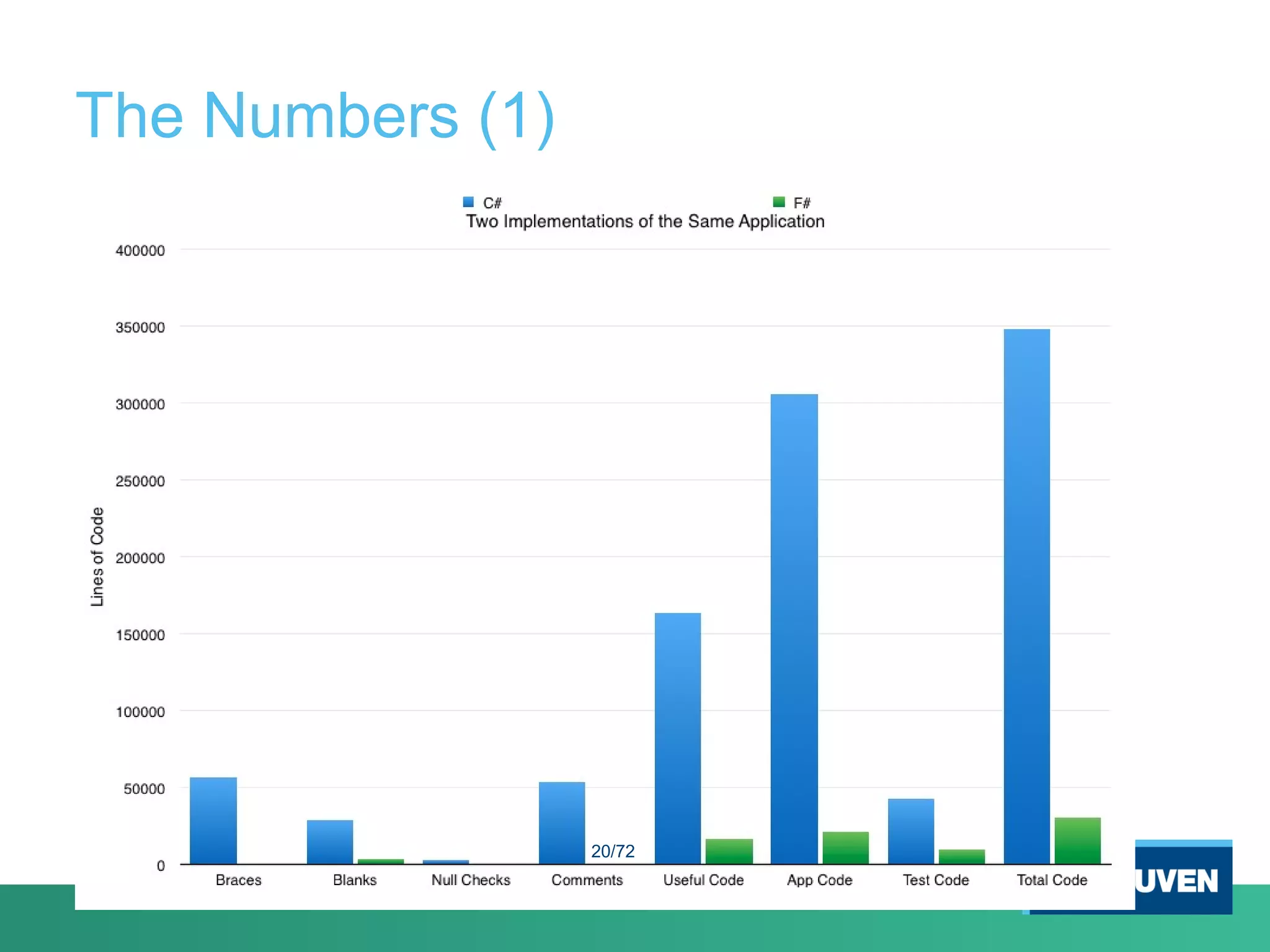

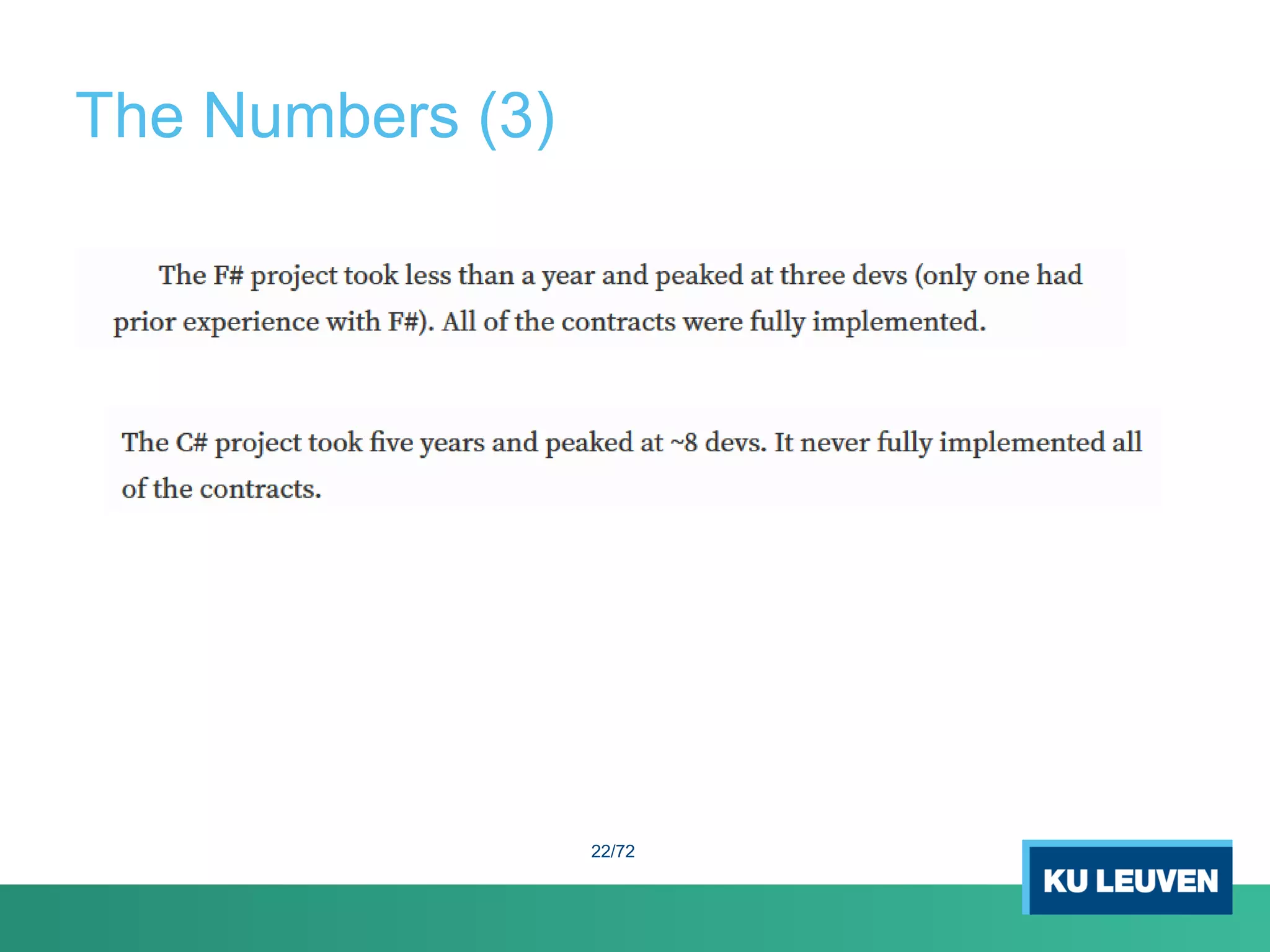
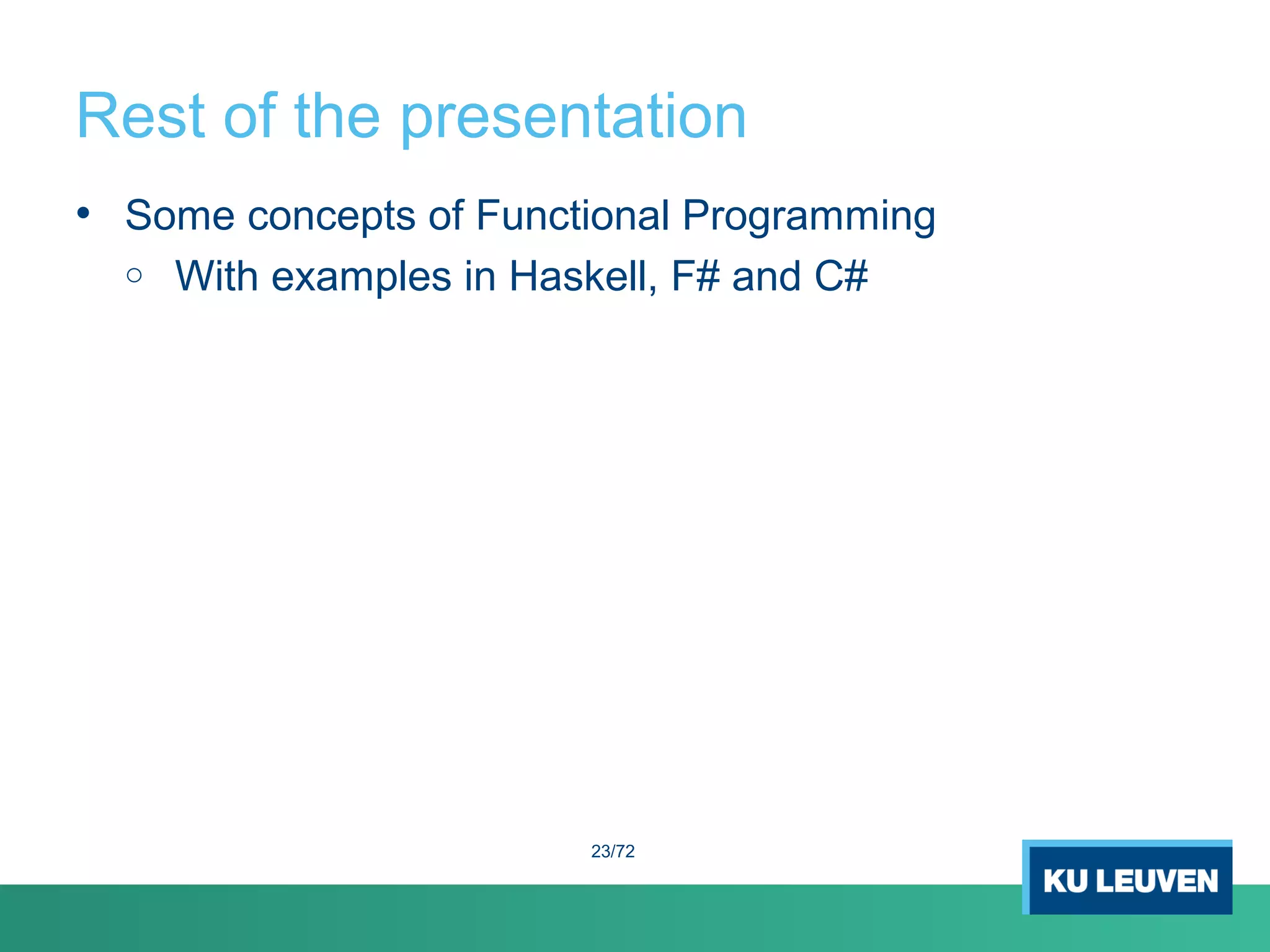
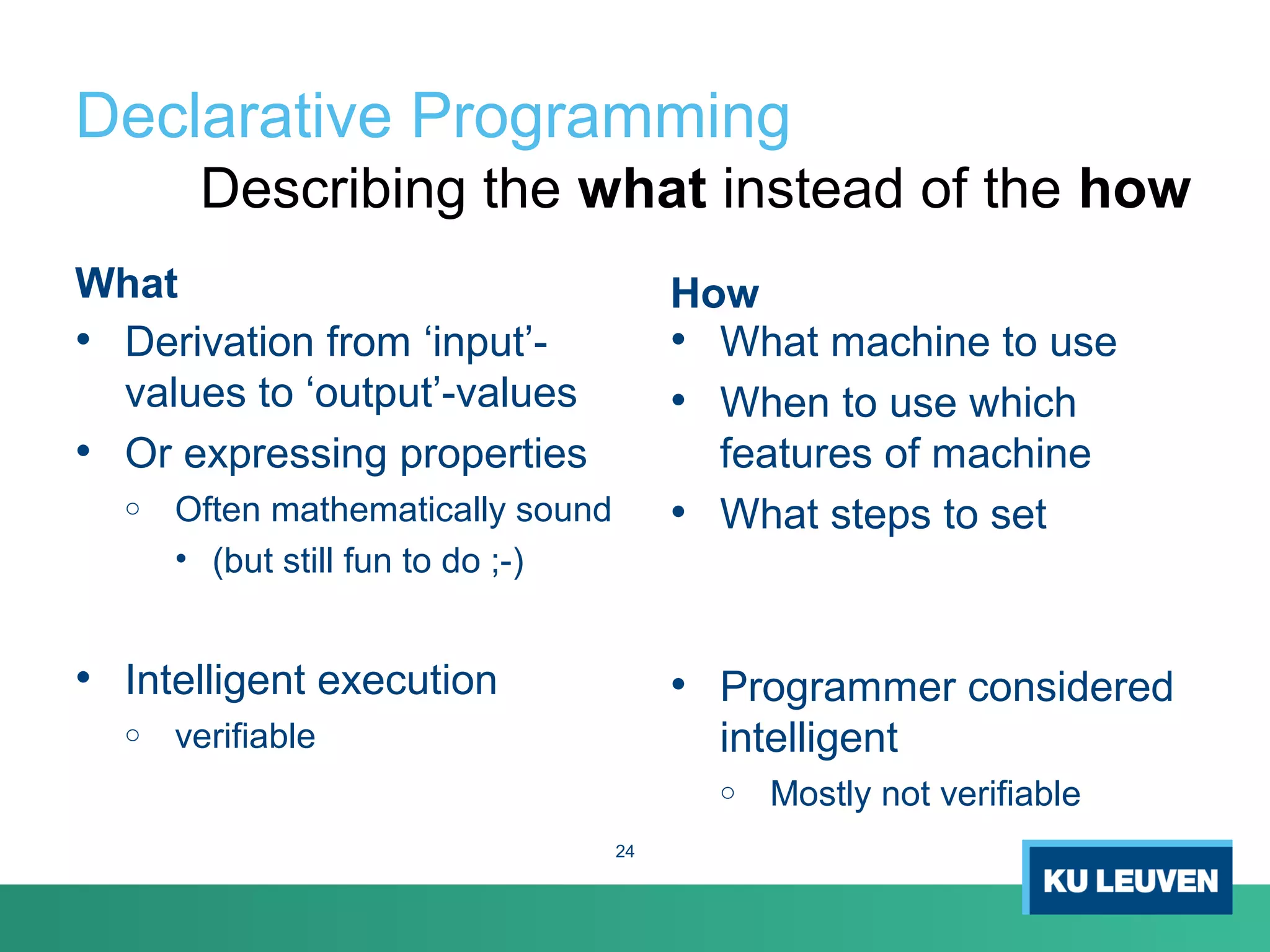
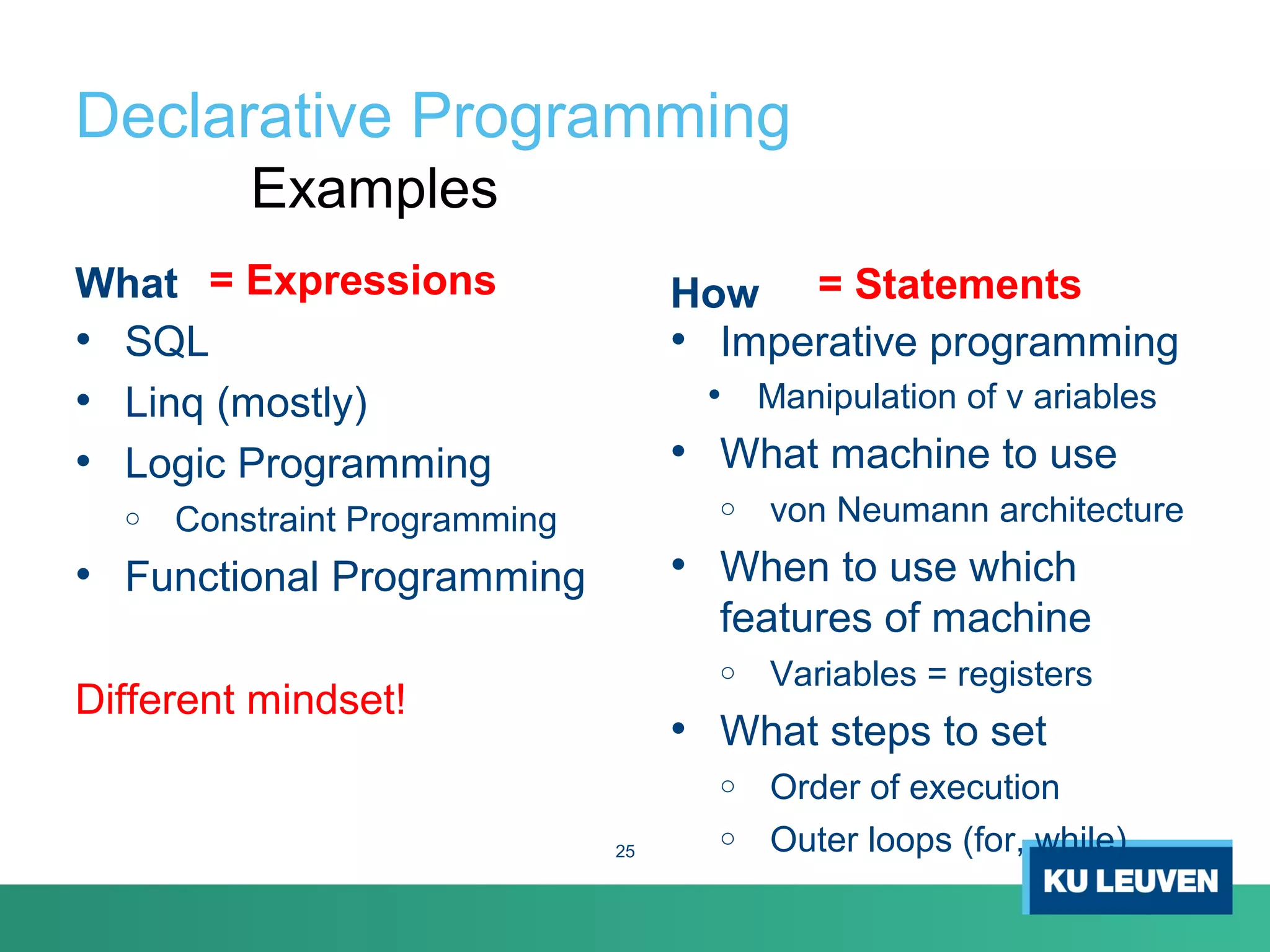
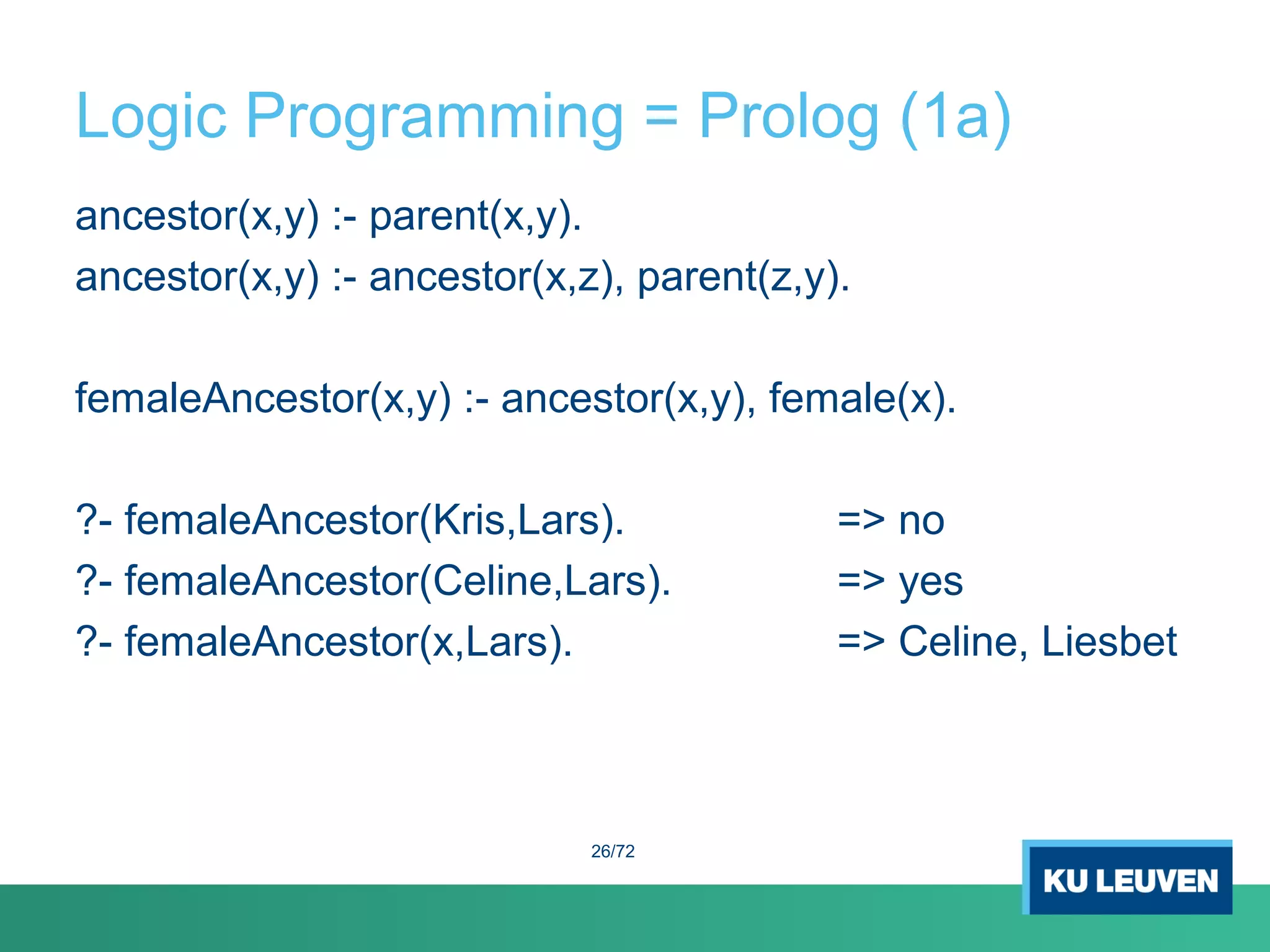

![Logic Programming = Prolog (2) evenNumber([]). even([_,_|T]):- evenNumber(T). palindrome(L):- reverse(L,L). reverse([],[]). reverse([H|T],R):- reverse(T,T1),append(T1,[H],R). 28/72](https://image.slidesharecdn.com/b1f1e00c-5084-4427-adf7-d427823dc020-150618071544-lva1-app6891/75/Presentation-of-GetTogether-on-Functional-Programming-27-2048.jpg)

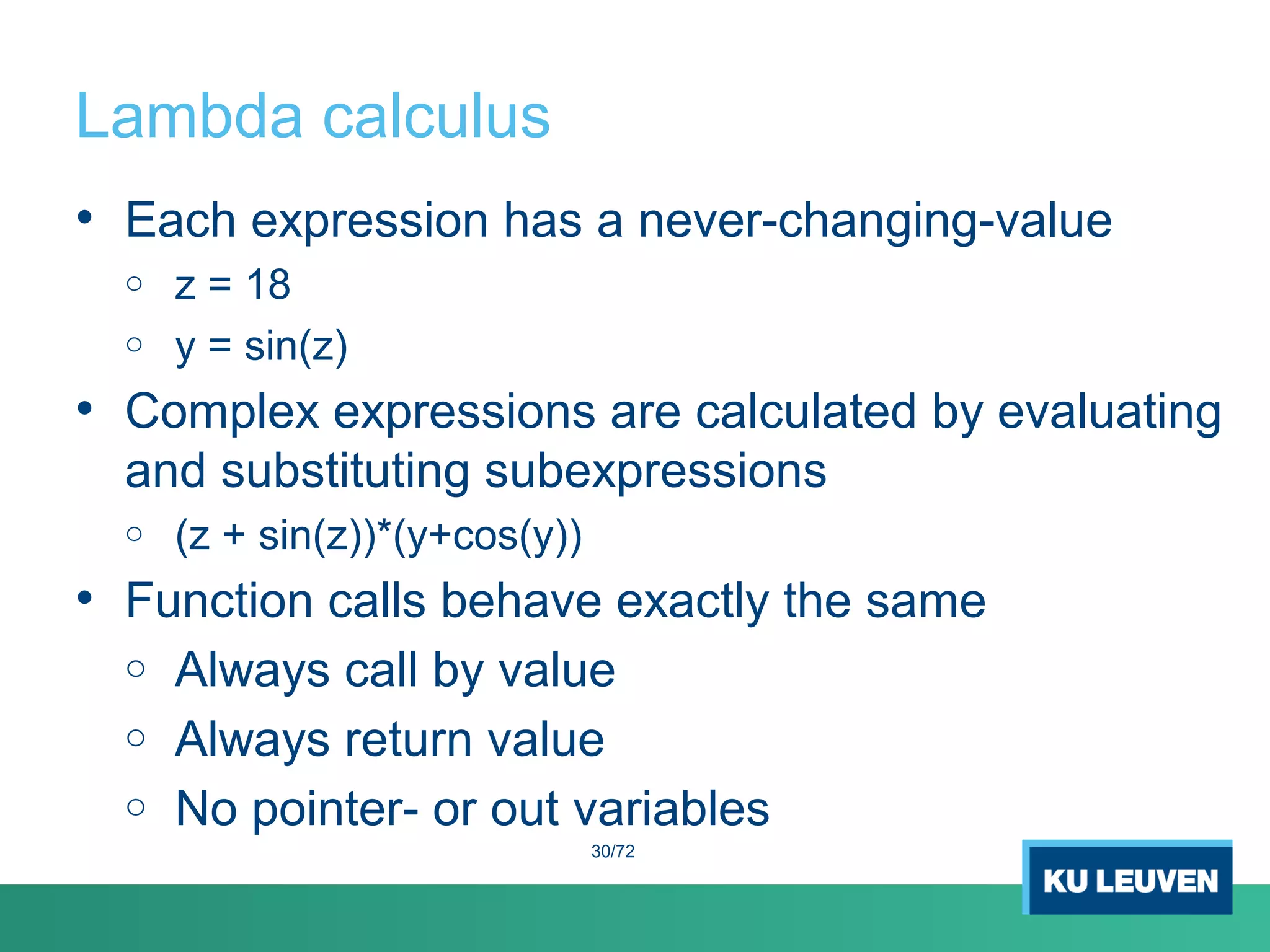
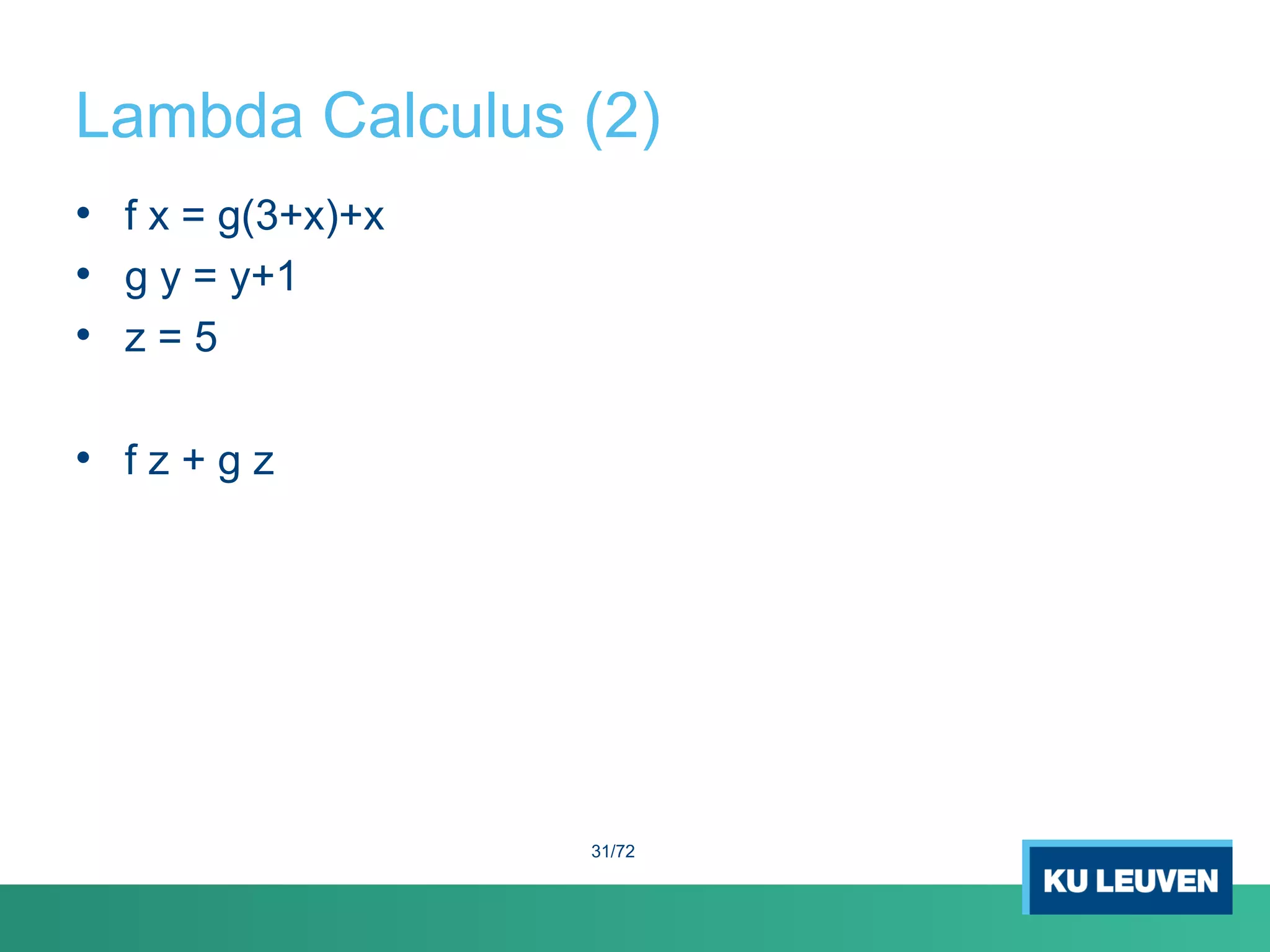
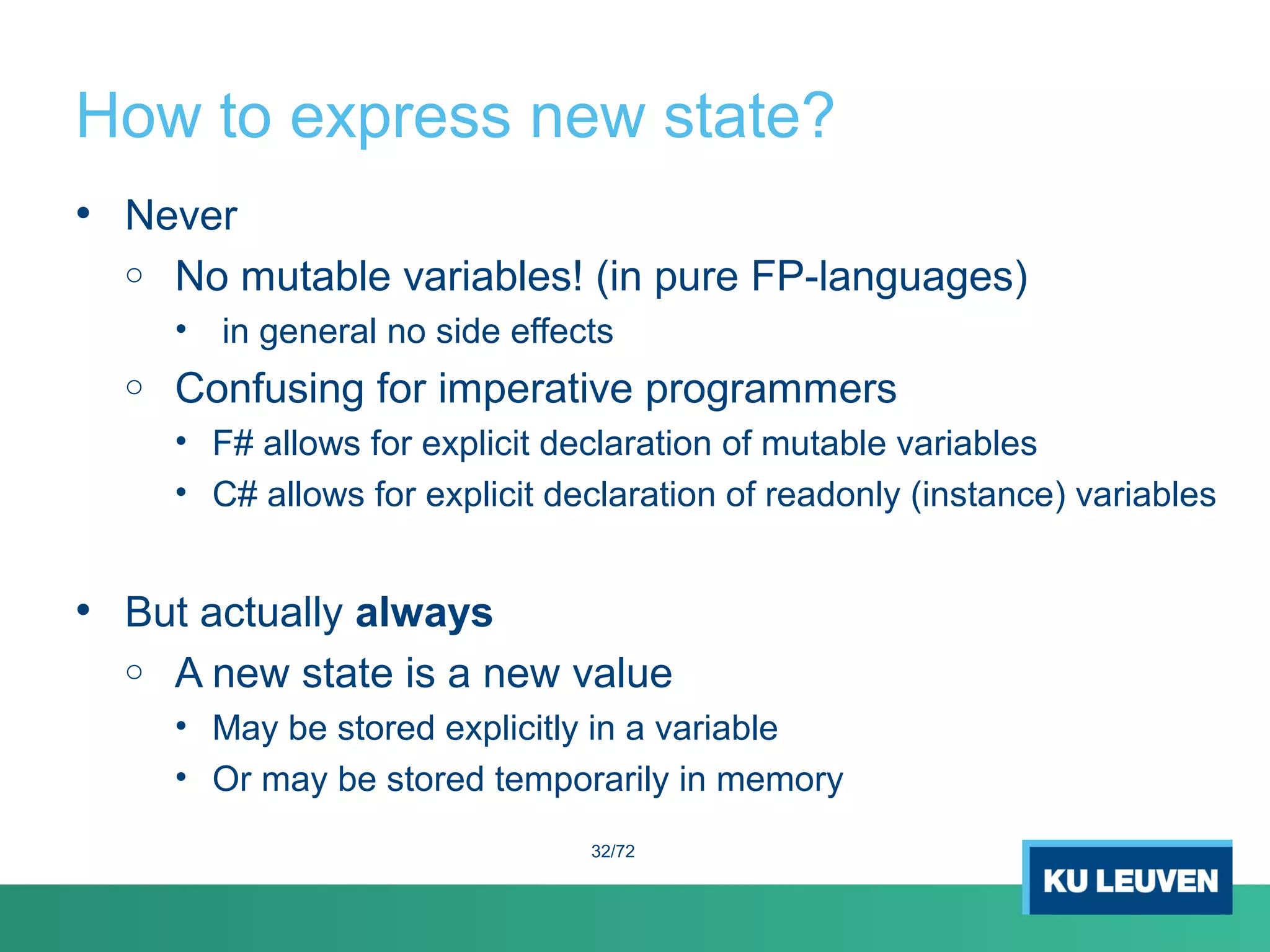
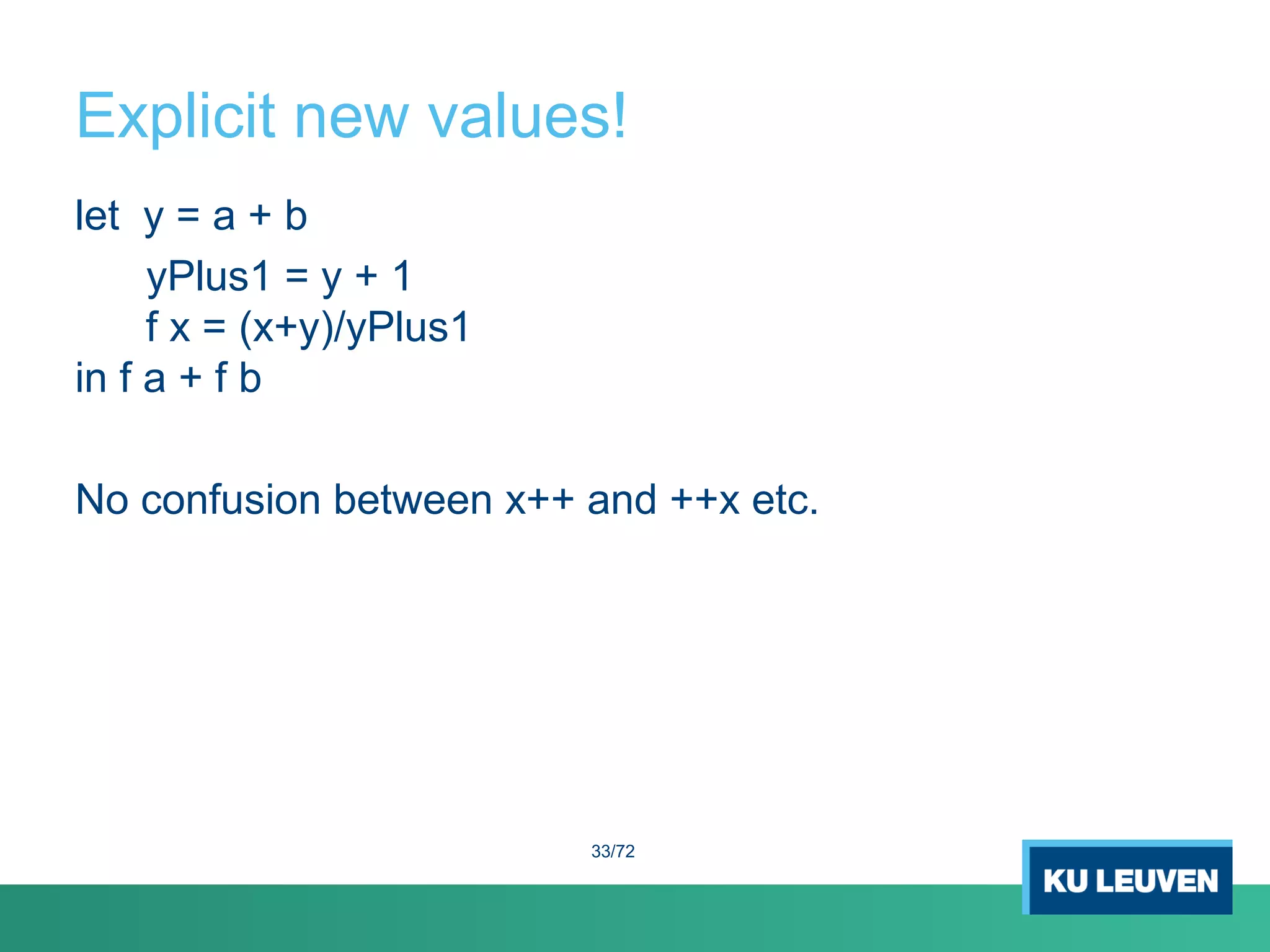
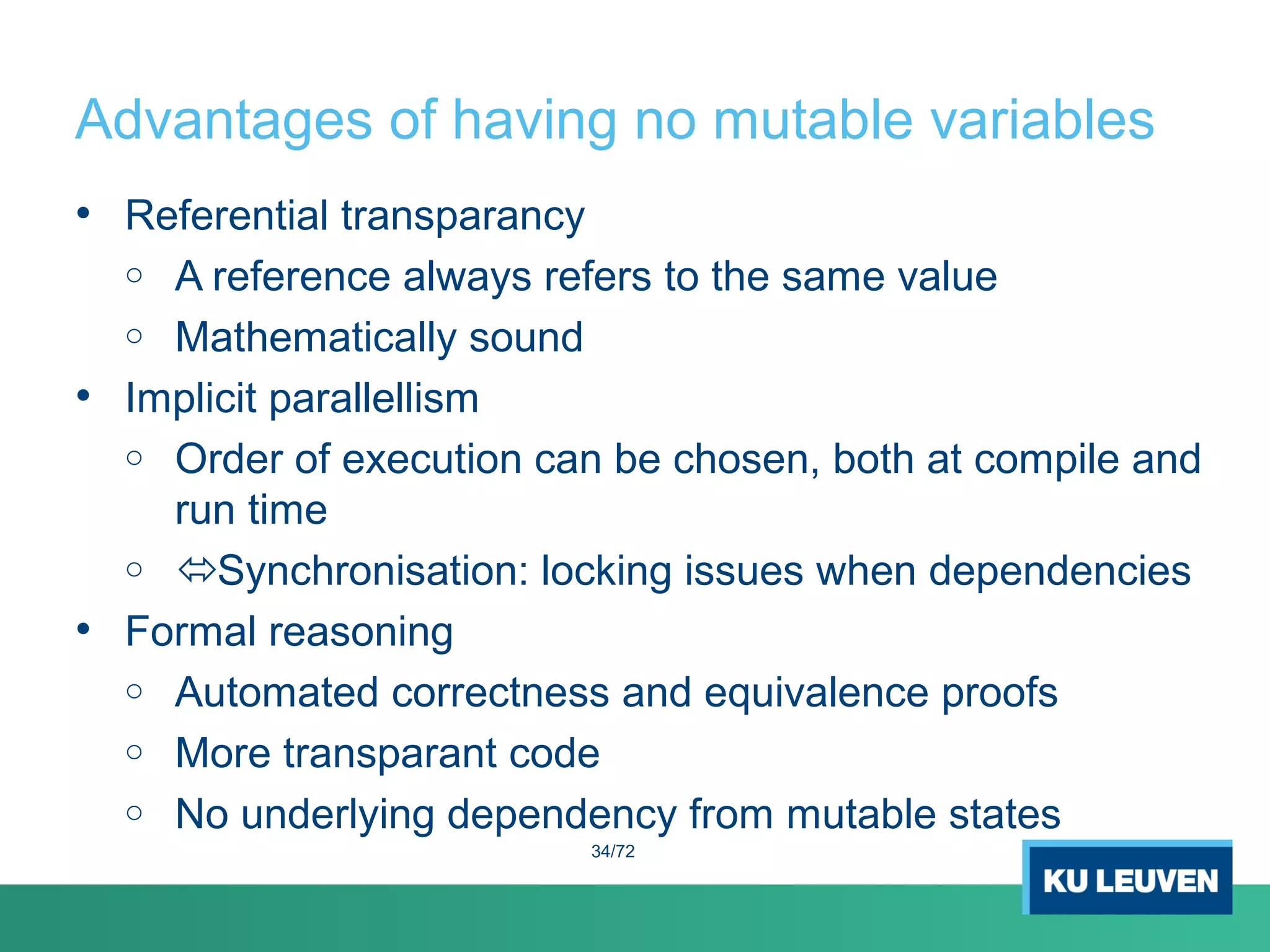
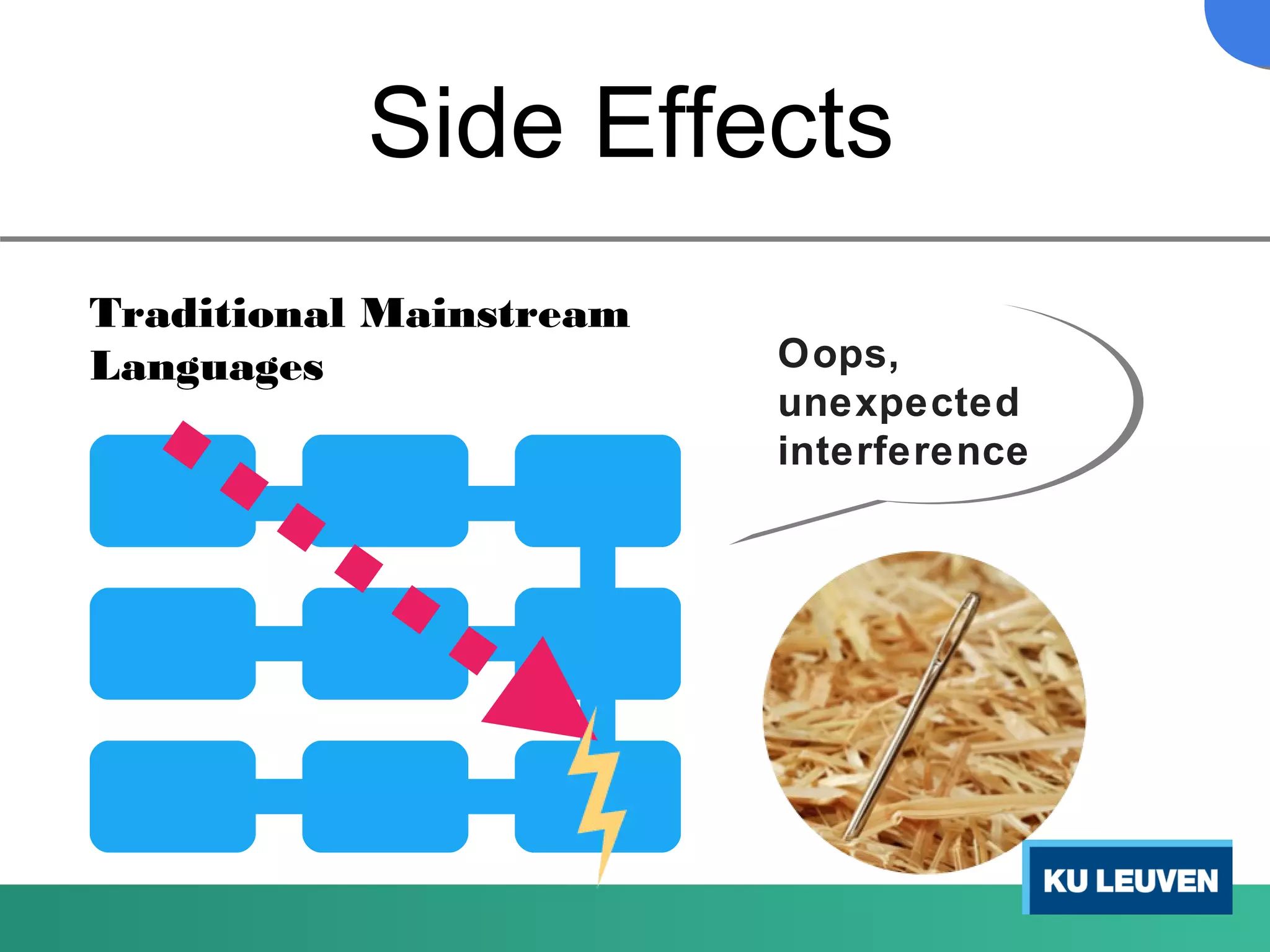

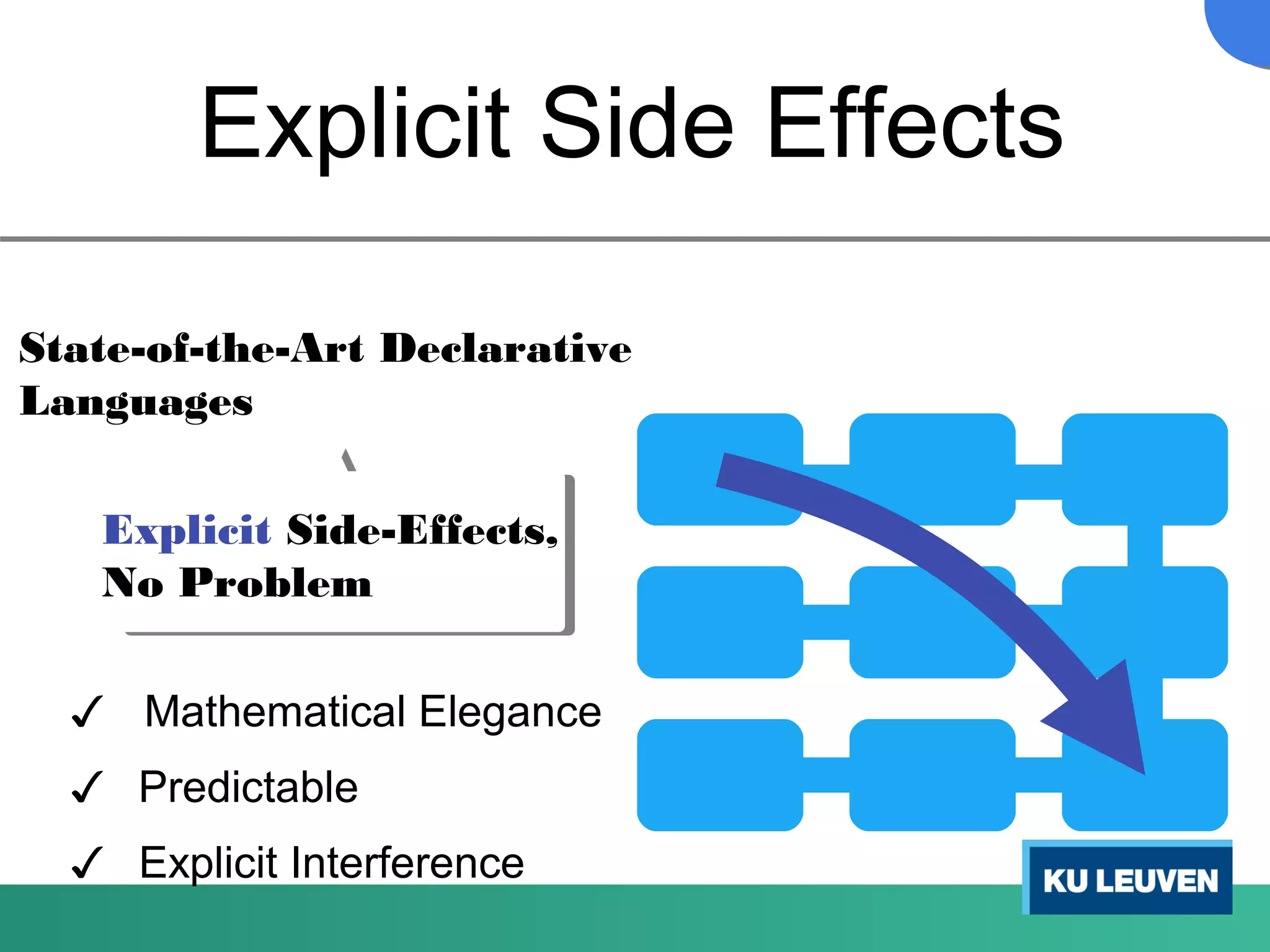

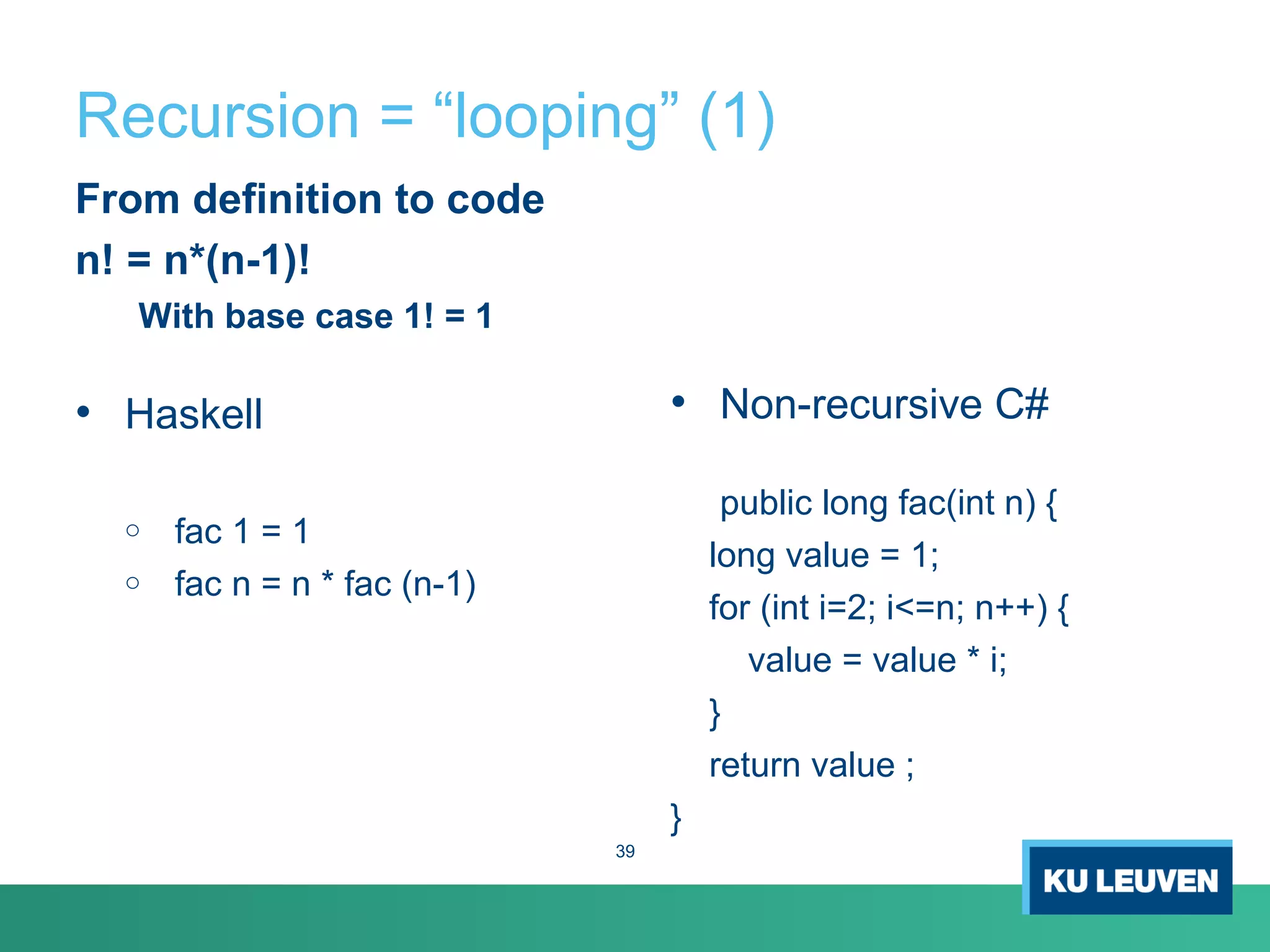

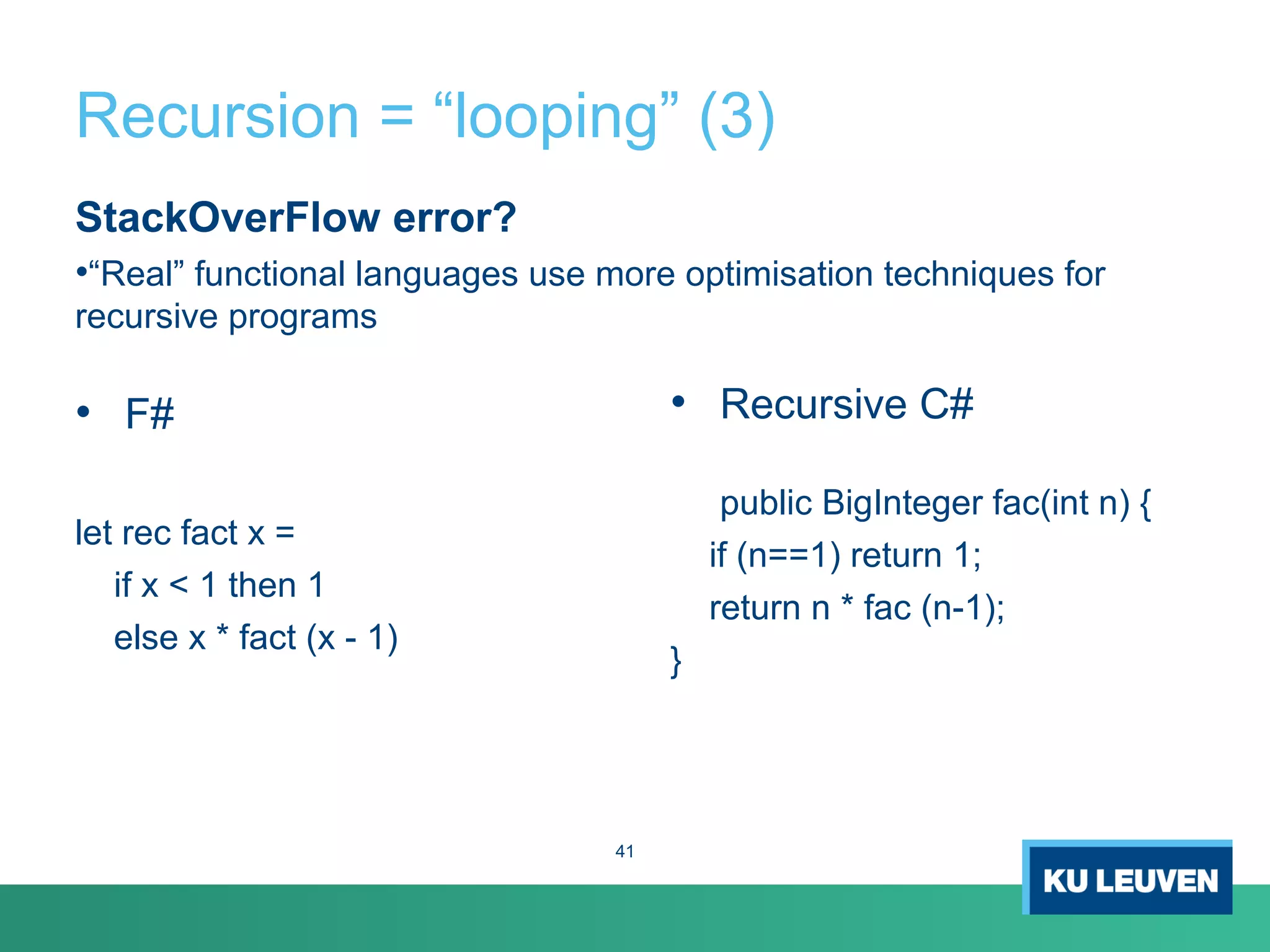
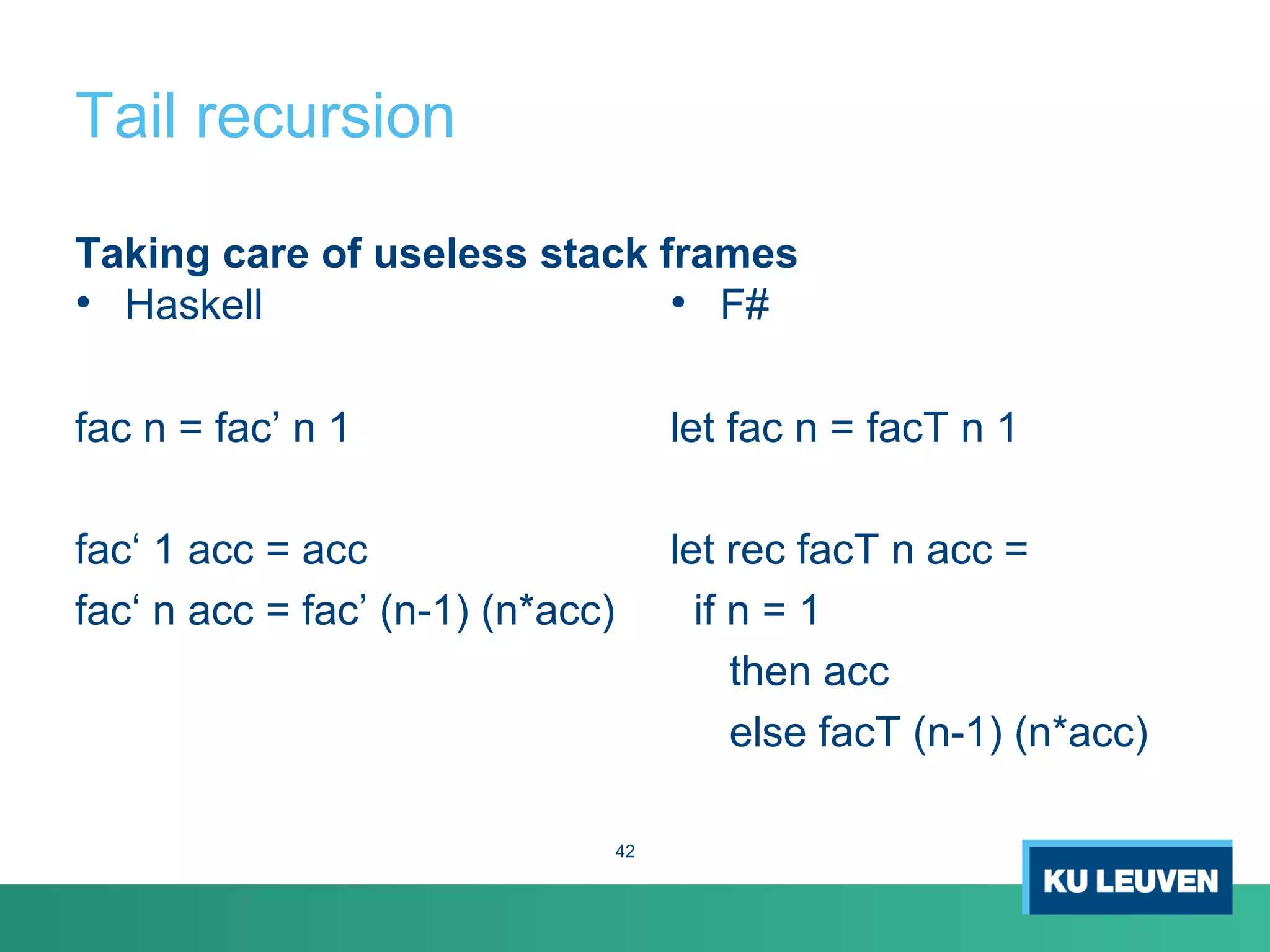

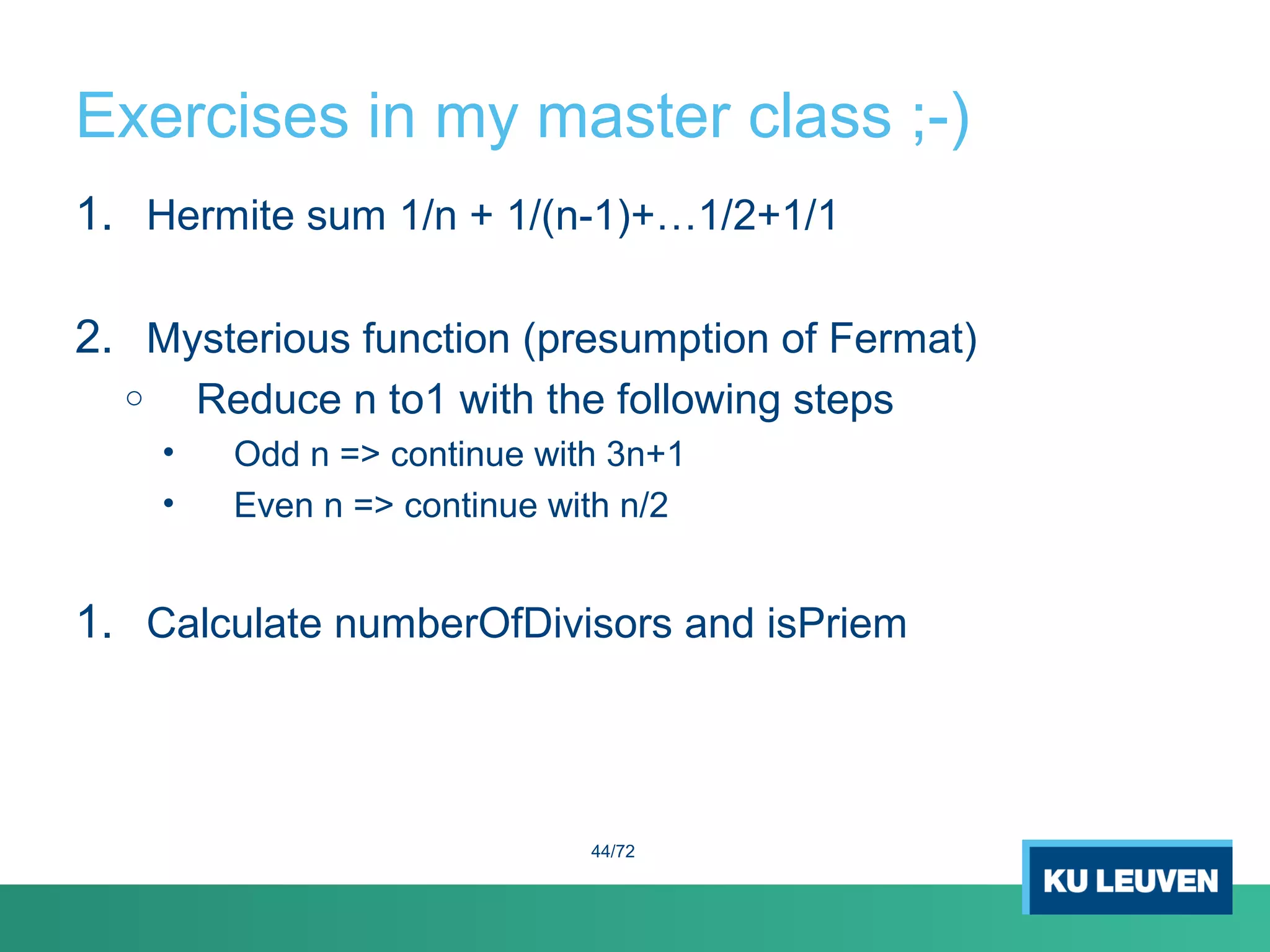
![Solutions in Haskell herm 1 = 1 herm n = 1/n + (herm (n-1)) myst 1 = [1] myst n | mod n 2 == 0 = n:(myst (div n 2)) | otherwise = n:(myst (3*n+1)) numberOfDivisors … isPrime n = (numberOfDivisors n) == 2 45/72](https://image.slidesharecdn.com/b1f1e00c-5084-4427-adf7-d427823dc020-150618071544-lva1-app6891/75/Presentation-of-GetTogether-on-Functional-Programming-44-2048.jpg)

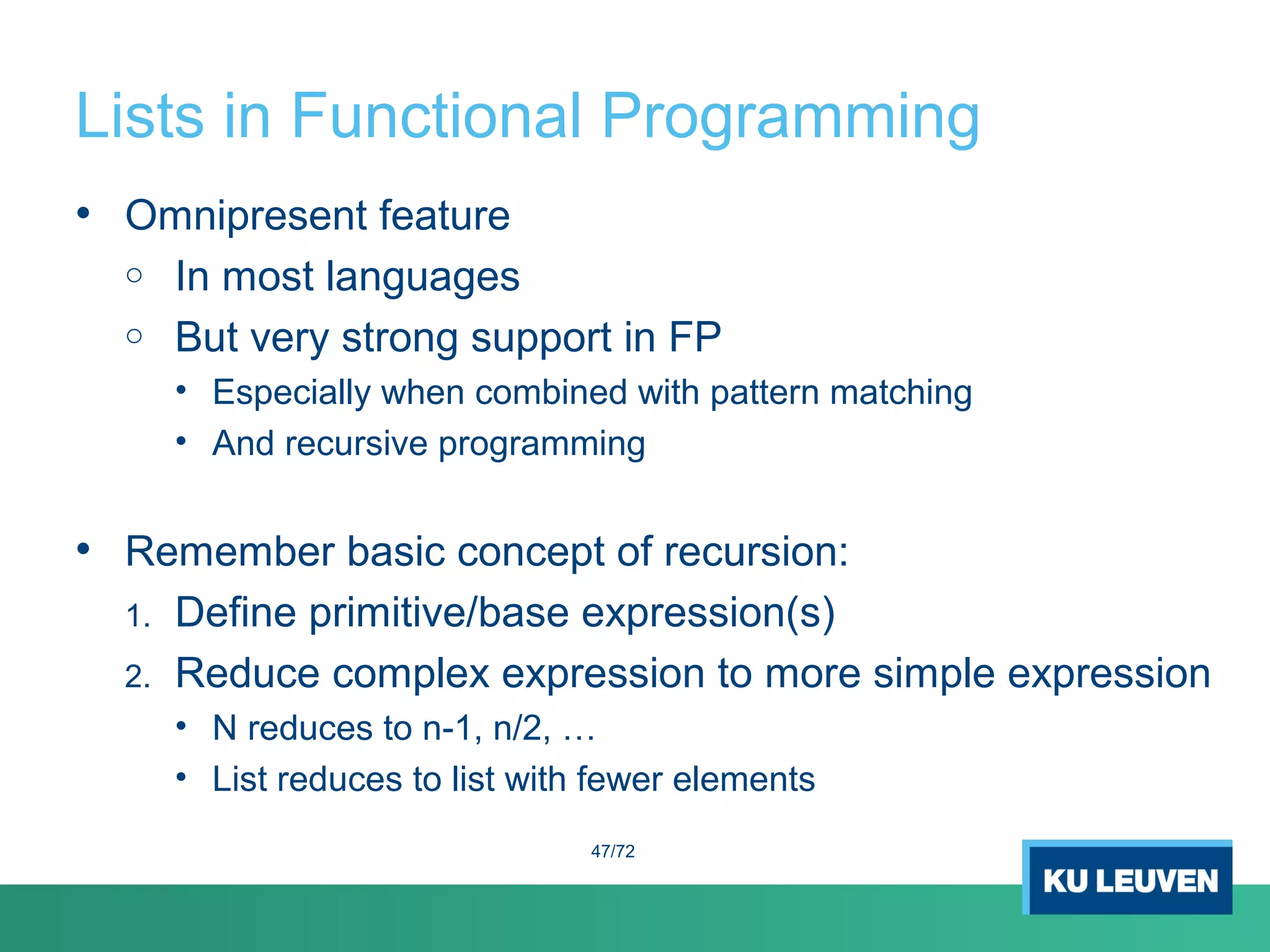
![Pattern matching in Haskell fac 1 = 1 fac n = n * fac (n-1) findValue [] y = False findValue (x:xs) y = if x == y then True else findValue xs y evenElems [] = True evenElems [x] = False evenElems (x:y:ys) = evenElems ys 48/72](https://image.slidesharecdn.com/b1f1e00c-5084-4427-adf7-d427823dc020-150618071544-lva1-app6891/75/Presentation-of-GetTogether-on-Functional-Programming-47-2048.jpg)
![Pattern matching in F# findValue [] y = False findValue (x:xs) y = if x == y then True else findValue xs y let rec findValue list x = match list with | [] -> False | y::ys -> if x == y then True else findValue x ys 49/72](https://image.slidesharecdn.com/b1f1e00c-5084-4427-adf7-d427823dc020-150618071544-lva1-app6891/75/Presentation-of-GetTogether-on-Functional-Programming-48-2048.jpg)
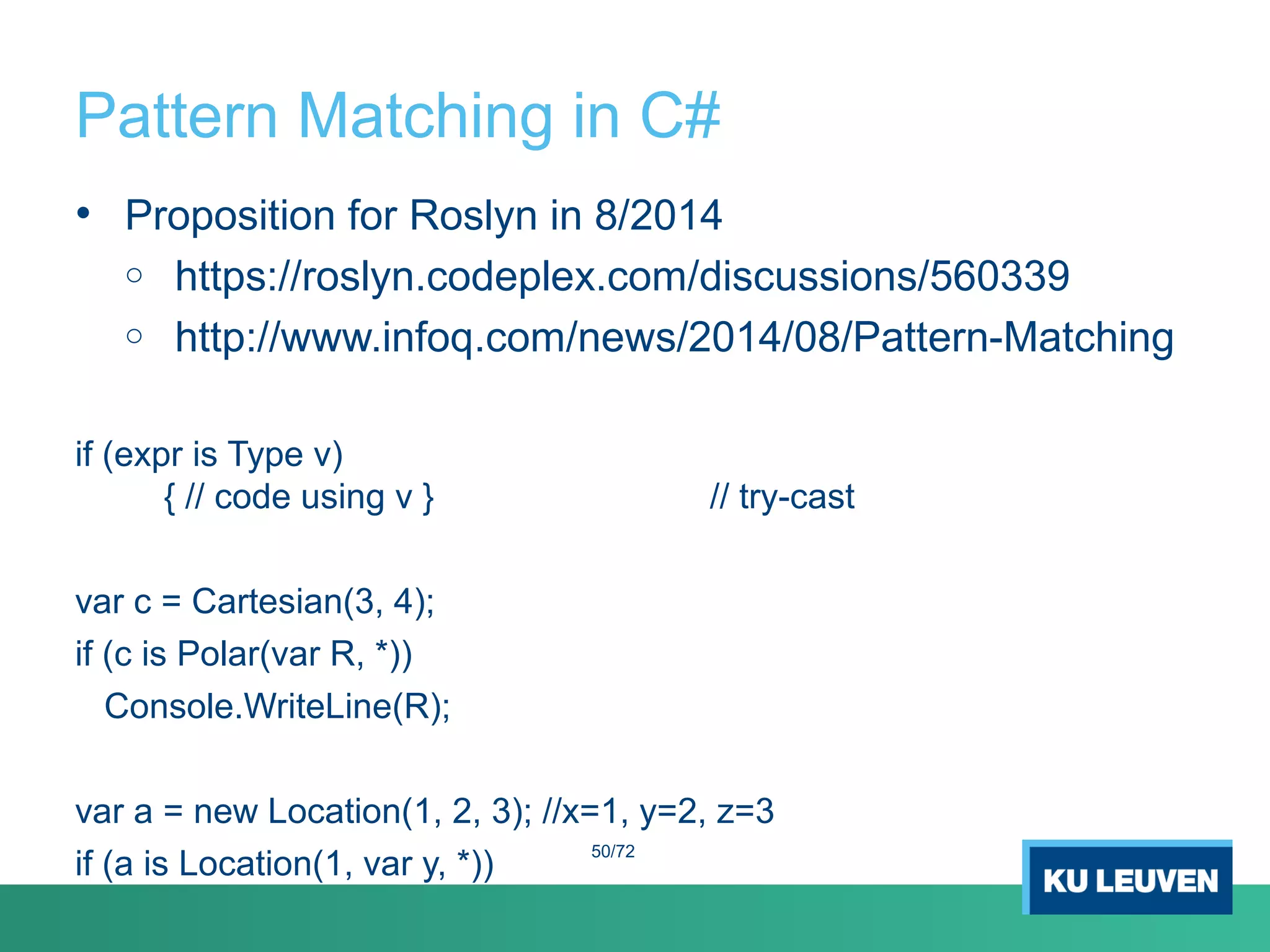


![Insert sort in Haskell isort [ ] = [ ] isort (x:xs) = insert x (isort xs) insert x [ ] = [x] insert x (y:ys) = if (x<y) then (x:y:ys) else y:(insert x ys) Barely new syntax needed! 53/72](https://image.slidesharecdn.com/b1f1e00c-5084-4427-adf7-d427823dc020-150618071544-lva1-app6891/75/Presentation-of-GetTogether-on-Functional-Programming-52-2048.jpg)
![Insert sort in F# let rec insert x l = match l with | [] -> [x] | y::ys -> if x <= y then x::y::ys else y::insert x ys and insertsort l = match l with | [] -> [] | x::xs -> insert x (insertsort xs) Source: http://www.codecodex.com/wiki/Insertion_sort 54/72](https://image.slidesharecdn.com/b1f1e00c-5084-4427-adf7-d427823dc020-150618071544-lva1-app6891/75/Presentation-of-GetTogether-on-Functional-Programming-53-2048.jpg)
![Insert sort in C# (non-functional) static void InsertSort(IComparable[] array) { int i, j; for (i = 1; i < array.Length; i++) { IComparable value = array[i]; j = i - 1; while ((j >= 0) && (array[j].CompareTo(value) > 0)) { array[j + 1] = array[j]; j=j-1; } array[j + 1] = value; } } 55/72](https://image.slidesharecdn.com/b1f1e00c-5084-4427-adf7-d427823dc020-150618071544-lva1-app6891/75/Presentation-of-GetTogether-on-Functional-Programming-54-2048.jpg)
![Type Classes and type inference • Note the explicit IComparable[] array in function type o static void InsertSort(IComparable[] array) • In Haskell implicit and auto-detected 56/72](https://image.slidesharecdn.com/b1f1e00c-5084-4427-adf7-d427823dc020-150618071544-lva1-app6891/75/Presentation-of-GetTogether-on-Functional-Programming-55-2048.jpg)
![Polymorfic: look at the types • Typ “:i isort” at command prompt of Haskell Interpreter o isort :: Ord a => [a] -> [a] • Similar o halfList :: [a] -> [a] o findValue :: Eq a => [a] -> a -> Bool o fac :: (Num a, Eq a) => a -> a 57/72](https://image.slidesharecdn.com/b1f1e00c-5084-4427-adf7-d427823dc020-150618071544-lva1-app6891/75/Presentation-of-GetTogether-on-Functional-Programming-56-2048.jpg)
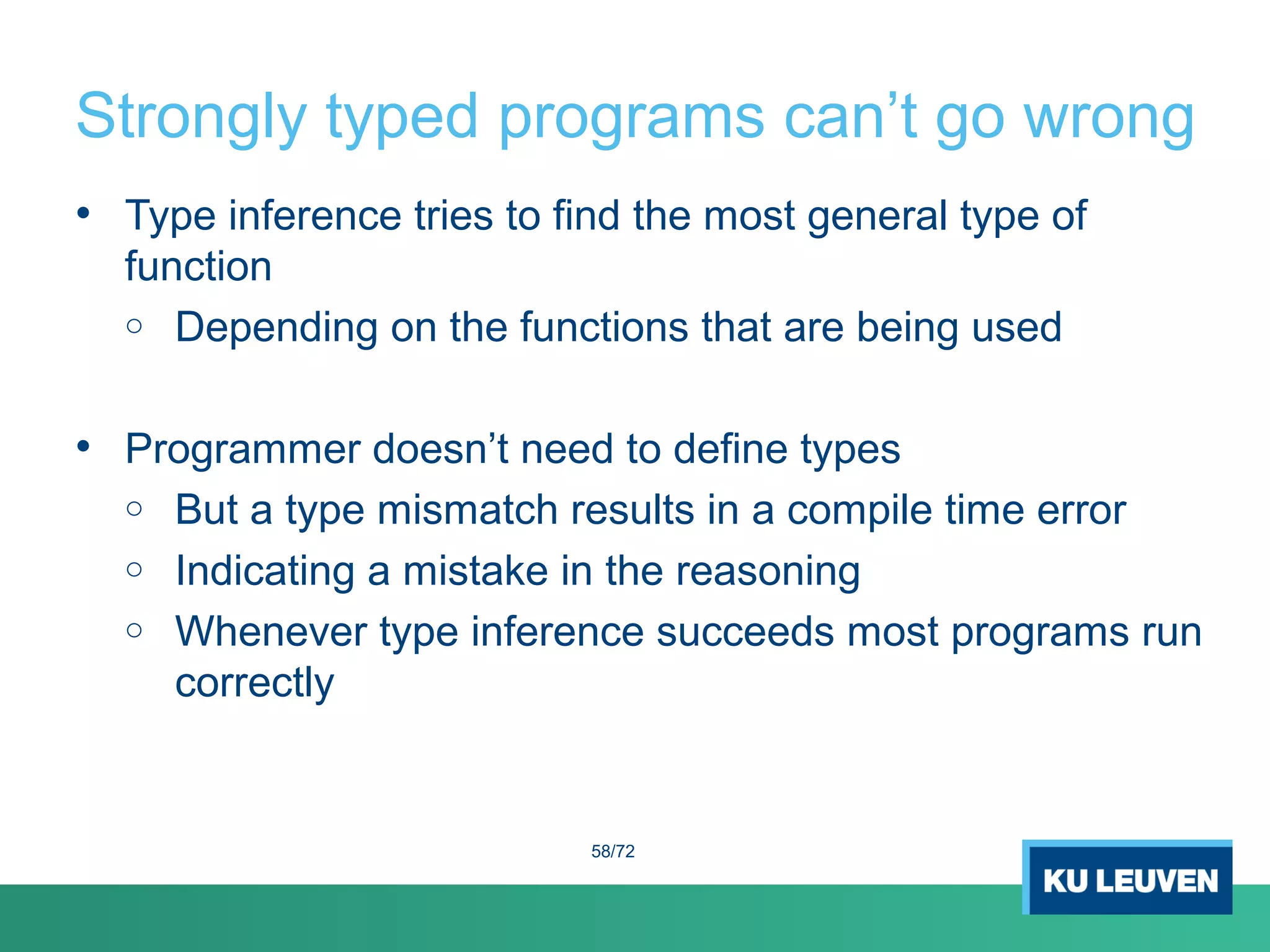
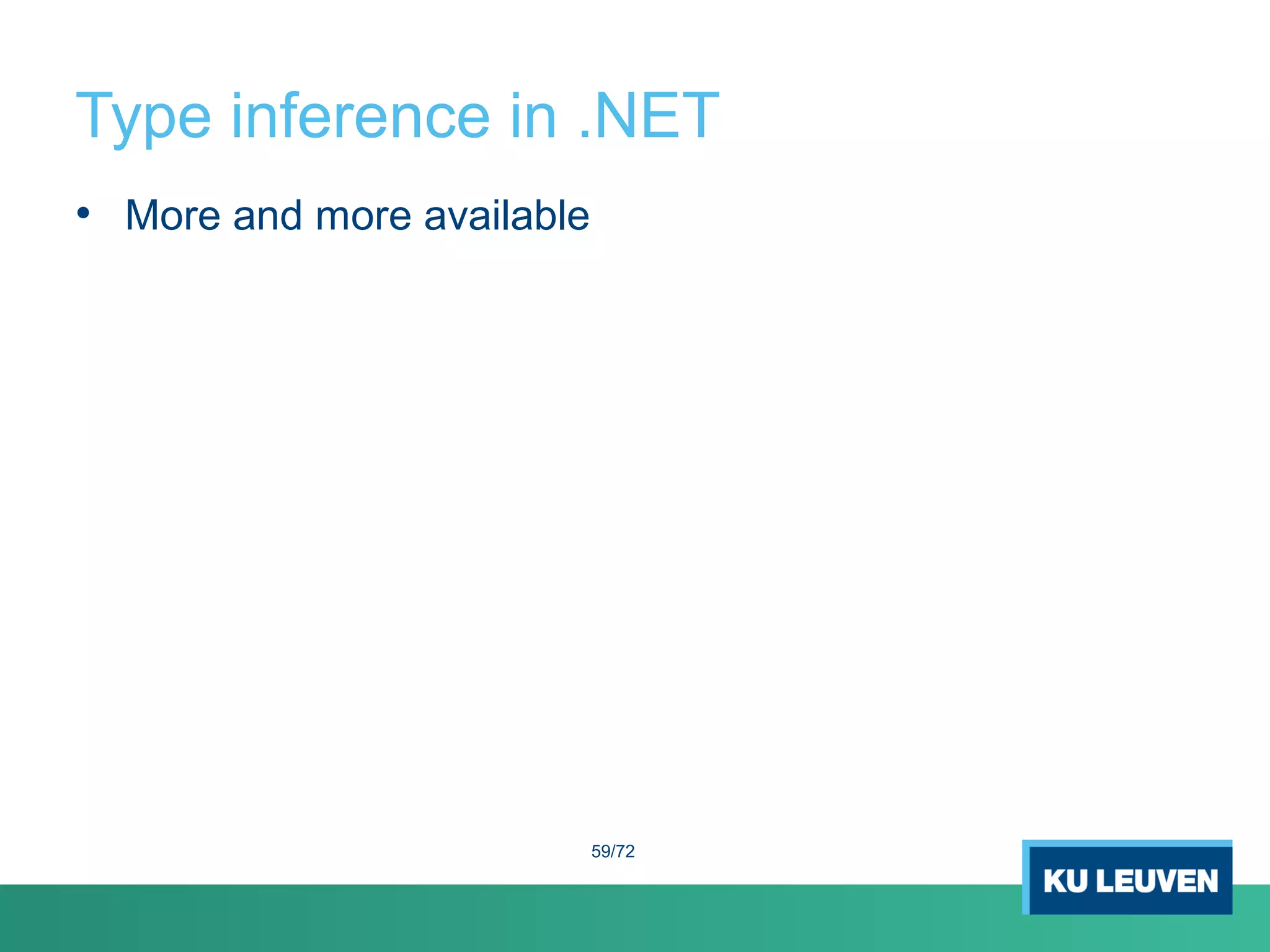
![List Comprehensions in Haskell Very declarative constructor -- give all even numbers of a list evens list = [x | x <- list, even x] inBoth list1 list2 = [x | x <- list1, findValue x list2] combine list1 list2 = [(x,y) | x <- list1, y <- list2] 60/72](https://image.slidesharecdn.com/b1f1e00c-5084-4427-adf7-d427823dc020-150618071544-lva1-app6891/75/Presentation-of-GetTogether-on-Functional-Programming-59-2048.jpg)
![List Comprehensions in Haskell Very declarative constructor -- give all even numbers of a list evens list = [x | x <- list, even x] inBoth list1 list2 = [x | x <- list1, findValue x list2] combine list1 list2 = [(x,y) | x <- list1, y <- list2] 61/72](https://image.slidesharecdn.com/b1f1e00c-5084-4427-adf7-d427823dc020-150618071544-lva1-app6891/75/Presentation-of-GetTogether-on-Functional-Programming-60-2048.jpg)
![List Comprehensions in F# [for x in collection do ... yield expr] seq { for x in 0..100 do if x*x > 3 then yield 2*x } ;; evens list = [x | x <- list, even x] inBoth list1 list2 = [x | x <- list1, findValue x list2] combine list1 list2 = [(x,y) | x <- list1, y <- list2] 62/72](https://image.slidesharecdn.com/b1f1e00c-5084-4427-adf7-d427823dc020-150618071544-lva1-app6891/75/Presentation-of-GetTogether-on-Functional-Programming-61-2048.jpg)
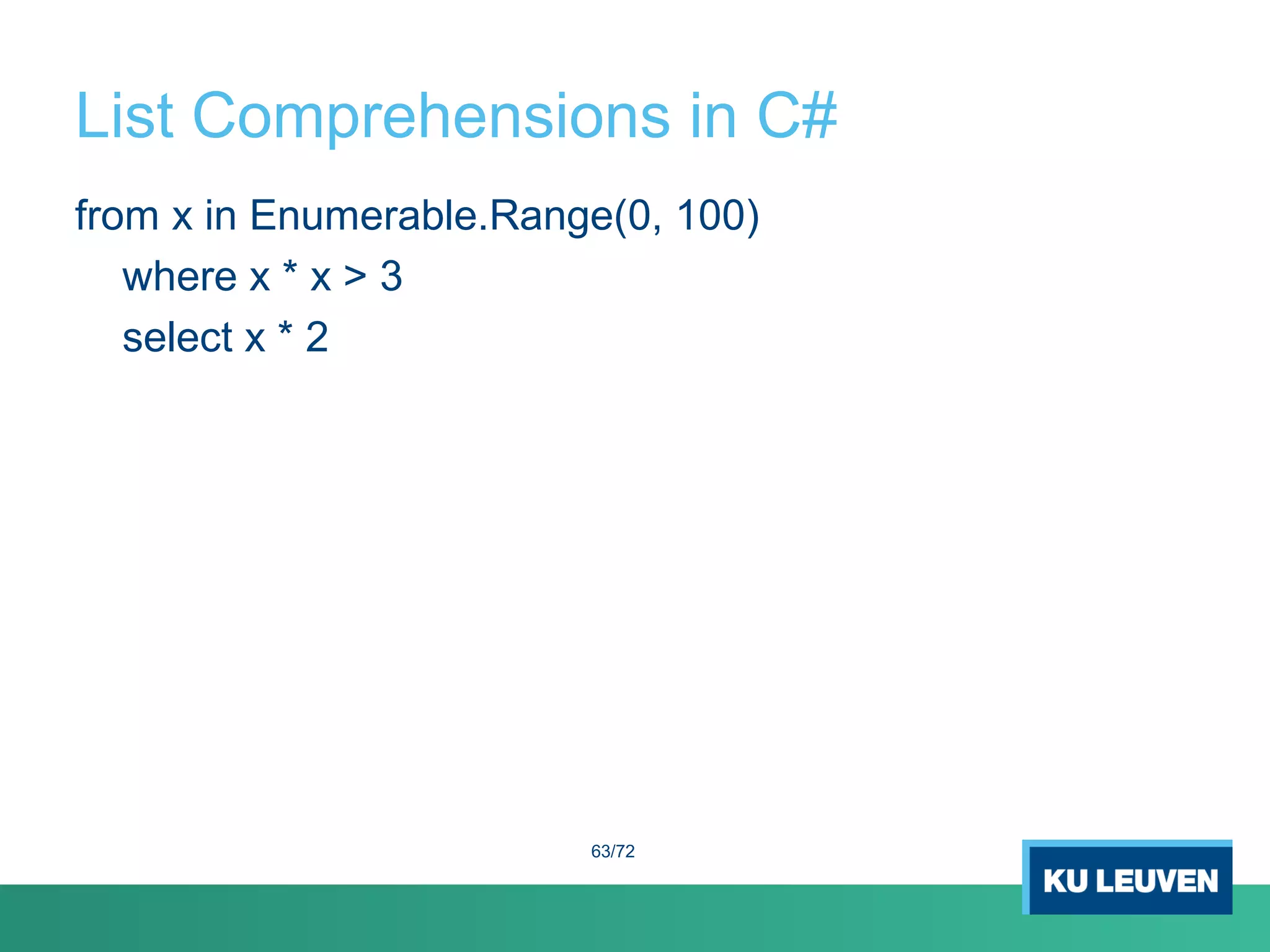
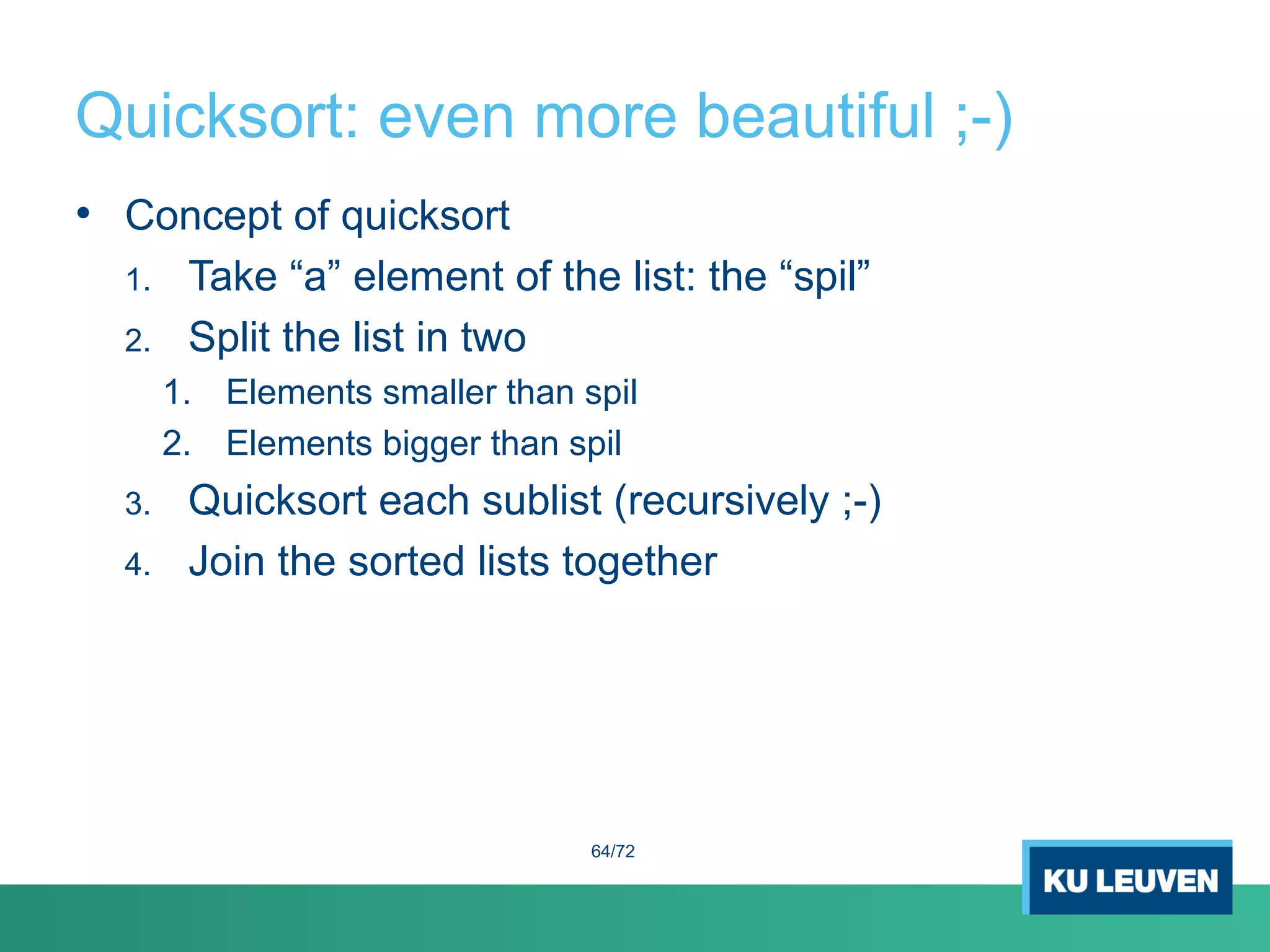
![Quicksort in Haskell qsort [] = [] qsort [x] = [x] qsort (x:xs) = let smaller = qsort([y | y <- xs, y < x]) larger = qsort([y | y <- xs, y > x]) in smaller ++ (x:larger) 65/72](https://image.slidesharecdn.com/b1f1e00c-5084-4427-adf7-d427823dc020-150618071544-lva1-app6891/75/Presentation-of-GetTogether-on-Functional-Programming-64-2048.jpg)
![Quicksort in F# let rec qsort:int list -> int list = function | [] -> [] | x::xs -> let smaller = [for a in xs do if a<=x then yield a] let larger = [for b in xs do if b>x then yield b] qsort smaller @ [x] @ qsort larger let rec qsort = function | [] -> [] | x::xs -> let smaller,larger = List.partition (fun y -> y<=x) xs qsort smaller @ [x] @ qsort larger 66/72](https://image.slidesharecdn.com/b1f1e00c-5084-4427-adf7-d427823dc020-150618071544-lva1-app6891/75/Presentation-of-GetTogether-on-Functional-Programming-65-2048.jpg)
![Higher order functions • Functions taking other functions as parameters • Simple list functions map & filter o map fac [3,6,2,4] o filter odd [1,2,3,4,5,6,7] • More Complex list functies foldr & foldl o Reduce a list to one value • Using a combining function • And a starting value o Foldr (+) 0 [1,2,3,4,5,6] 67/72](https://image.slidesharecdn.com/b1f1e00c-5084-4427-adf7-d427823dc020-150618071544-lva1-app6891/75/Presentation-of-GetTogether-on-Functional-Programming-66-2048.jpg)
![Recursion over functions repeatFun 0 f value = value repeatFun n f value = repeatFun (n-1) f (f value) bubbleSort list = repeatFun(length list) bubble list bubble [] = [] bubble [x] = [x] bubble (x:y:ys) | x < y = x:(bubble (y:ys)) | otherwise = y:(bubble (x:ys)) 68/72](https://image.slidesharecdn.com/b1f1e00c-5084-4427-adf7-d427823dc020-150618071544-lva1-app6891/75/Presentation-of-GetTogether-on-Functional-Programming-67-2048.jpg)

